Puglia - Brindisi - Things to do
Table of Contents

SEARCH ACCOMODATION Fasano
City cannot be null
Number of guests cannot be null
Zoosafari - having fun in Puglia - Fasano
Updated at: 25-03-2024
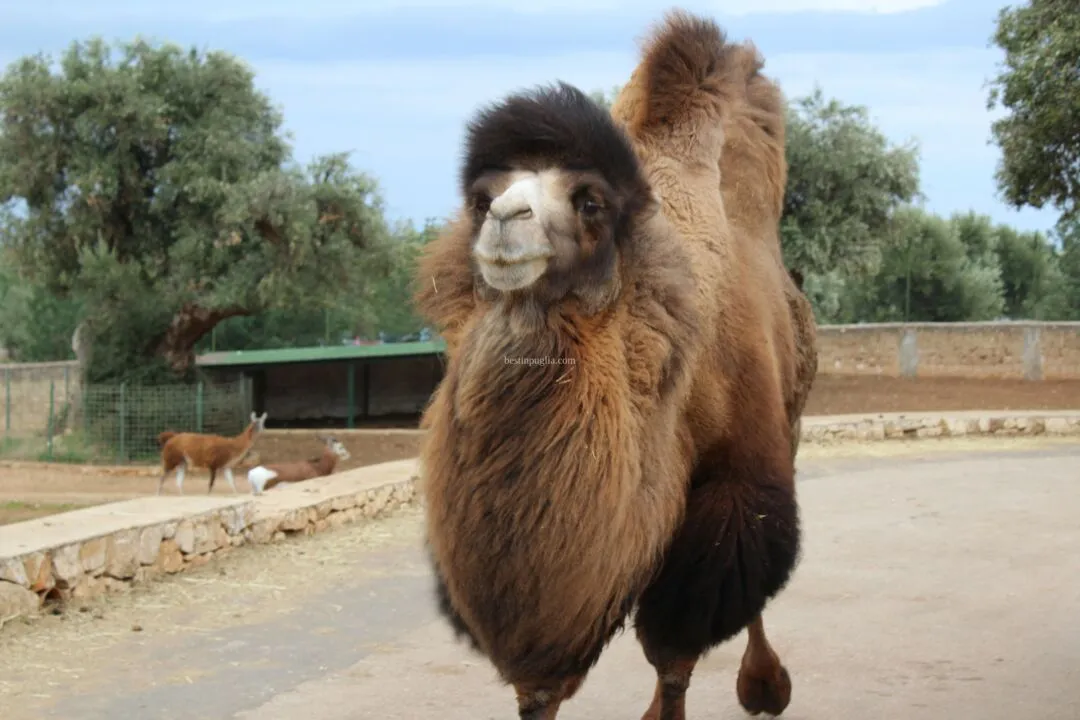
In the list of things to do during your holiday in Puglia 2022, if you are looking for a little fun, there is a visit to the Fasano Safari Zoo; a place suitable for people of all ages.
The Zoo of Fasano also known as Zoo Safari, Zoo Fasano or Fasanolandia is an important tourist attraction located in Fasano, in the province of Brindisi . It is a complex consisting of a large zoo and an amusement park called Fasanolandia. The area of the Fasano zoo extends for 30 hectares and is home to 200 different species of animals, which can be observed by crossing a path by car, like a real safari! We see below all the useful information for your visit to the Zoo Safari in Fasano.
Zoo Safari Fasano, Fasanolandia Zoo Fasano
The Fasano Zoo is characterized by a single large park, divided into two thematic areas:
- Fasanolandia
The Zoo Safari is the area used as a car route, which allows animals to be visited.
Fasanolandia is a real amusement park with rides and attractions
Where is Fasanolandia located?
Fasanolandia is located in Fasano, in the structure that already houses the Zoo Safari of Fasano.
A visit to the Zoo Safari of Fasano and Fasanolandia is certainly to be included in the places to visit in Puglia if you are on holiday in the areas of Brindisi.
The Fasano Zoo and Fasanolandia are suitable places for families with children and organized groups.
Zoo Fasano what to see
The Fasano safari zoo is one of the largest wildlife parks in Europe, with a large area and more than two hundred species of animals.
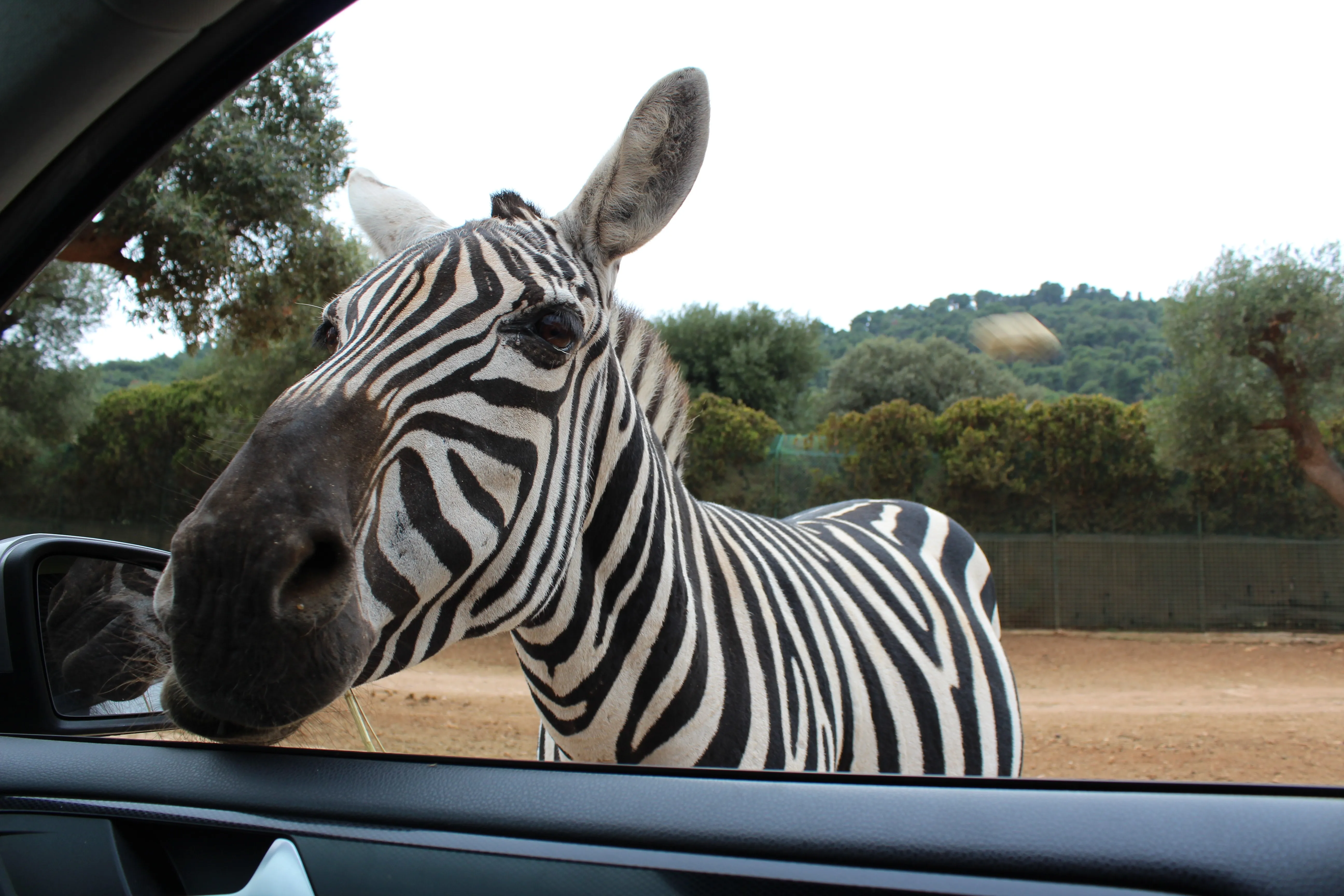
How much does the ticket for the Fasano zoo cost?
Zoo fasano price:.
The ticket for the Fasano Zoo costs 28 €. The prices of the fasanolandia zoo vary according to age. There are discounted prices for groups.
The ticket for the Fasano zoo offers the possibility to access the safari by car, to visit the reptile area, to visit the lake of the great mammals and to take the little train that will take you to the monkey village. The driving safari experience is definitely not to be missed!
There are also various rates depending on what you choose to see. You can choose to buy the entrance ticket only for the Fasano Zoo or only for the fasanolandia amusement park. You can buy your ticket for the fasanolandia zoosafari directly at the entrance.
The visit to the zoo lasts about an hour. However, the visit time may vary depending on the turnout. On holidays you will find a greater turnout and therefore the visiting time will get longer.
When does the Fasano safari zoo open?
Here are the opening and closing times of the Fasano zoo: the zoosafari is open every day starting at 9.30. The last possibility of entry is at 3.00 pm.
Our advice is to arrive in the morning. So you can enjoy an exciting safari and during lunch time you can choose one of the many places to eat. After seeing the animals you can have fun with the many rides in the park.
How to get to the Fasano zoosafari?
It is possible to reach the Fasano zoo by car or by train.
Traveling by car, just follow the signs for zoo Fasano.
Through the Bari - Lecce route you will arrive at the Fasano railway station. From here, you will have to reach the town center by bus. The park is a couple of kilometers from the city center. If you arrive at the Zoosafari di Fasano by public transport, you can take advantage of the pedestrian area to see the many animals.
Zoo Safari during the holidays
A peculiarity of the zoosafari is that during the holidays the Fasano zoo organizes the theme day. You will find the park decorated depending on the party in progress. Themed shows are organized during halloween. During Christmas the park is filled with decorations.

Visit the Zoosafari of Fasano
This is how the visit to the Fasano Zoo takes place:
Inside the Fasano zoosafari you can drive through an area passing among the animals, like a real safari. A journey immersed in nature. You will be able to meet giraffes, elephants, zebras and many others. You will see the animals up close, from your car. You will pass among the tigers and lions.
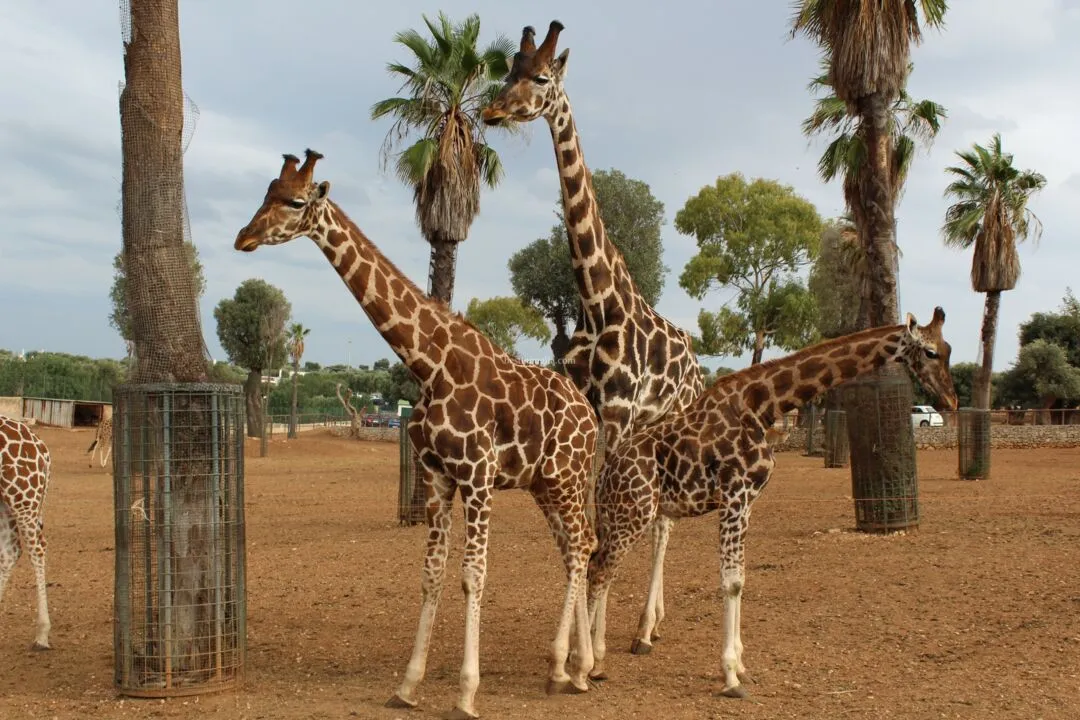
Moving on to the pedestrian visit you will observe chimpanzees, lemurs and other animal species. A small train, the Metrozoo, will take you to observe the lake of the great mammals. In this part of the park you will see polar bears, brown bears, rhinos and hippos.
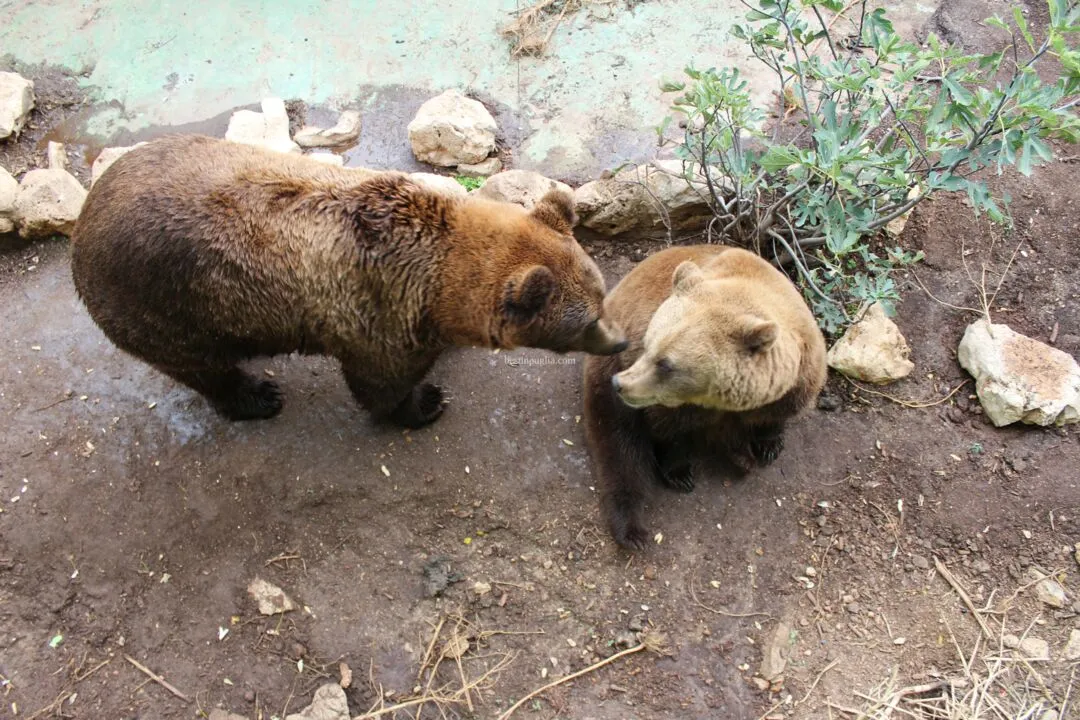
The Fasano Zoo ticket includes a visit to the area dedicated to reptiles. A tropical room where in various display cases you will see snakes and alligators.
For a small extra cost you can visit the Sealion aquarium. Here you will discover the world of penguins and sea lions.
After the tour at the Zoosafari in Fasano, you can head to the amusement park. Fasanolandia offers mechanical attractions for both adults and families and children. An area where you will also find exhibitions, museums and dining areas. You can also stop and watch one of the many organized shows.
The Fasano zoo and fasanolandia offer many paths among the animals and lots of fun.
What are you waiting for? Visit the safari zoo of Fasano and fasanolandia if you are looking for a day full of fun!

Zoo Safari of Fasano
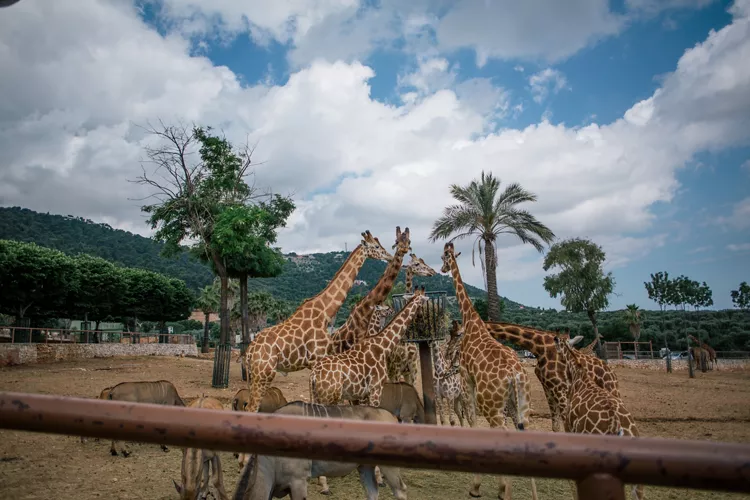
A large wildlife park close to the sea
The second-largest wildlife park in Europe is located just a few kilometres from Brindisi and a stone’s throw from some of Puglia ’s most beautiful coastal resorts, such as Polignano a Mare and Monopoli. We’re talking about the fantastic Zoosafari Fasanolandia in Fasano , a zoo and amusement park covering more than 30 hectares that catapults visitors into a natural oasis where you can admire over 1,700 animals belonging to 200 different species.
The history of the park begins in 1973 as just a zoo, the true heart of the Zoosafari . In the years that followed, it was decided to offer visitors even more, with adrenaline-pumping attractions and rides for the whole family in the area that goes by the name of Fasanolandia . However, the main attraction remains the zoo, which you can explore in your own car, following a circuit along which you can admire zebras and lions, Asian elephants and tigers, as well as giraffes, rhinoceroses and antelopes up close.
The Monkey Village lets you observe more than 300 baboons in full freedom on board a small train, while the large permanent ornithological exhibition gives you the opportunity to observe exotic birds and large birds of prey first hand.
Zoo Safari di Fasano, Strada Zoo Safari, 72015 Contrada Sant'Elia, Fasano BR, Italia
Related articles
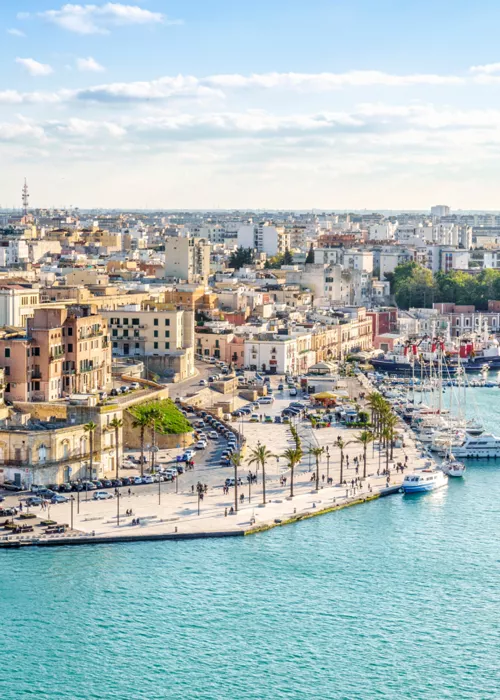
Brindisi is the world hub for digital nomads in Italy
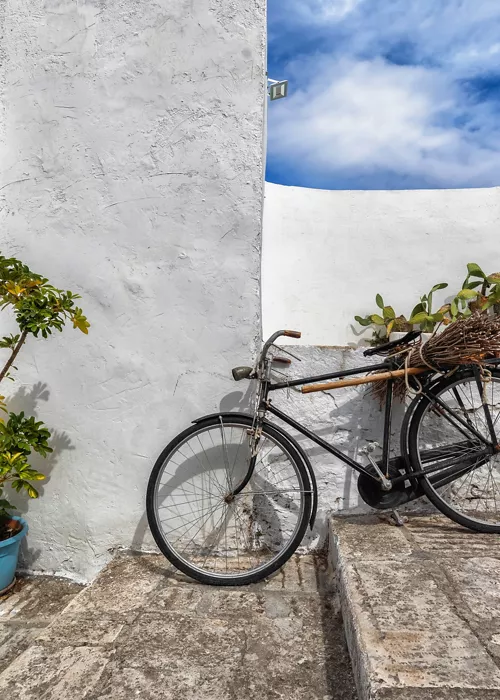
Puglia by bike: between trulli, olive groves and delightful villages
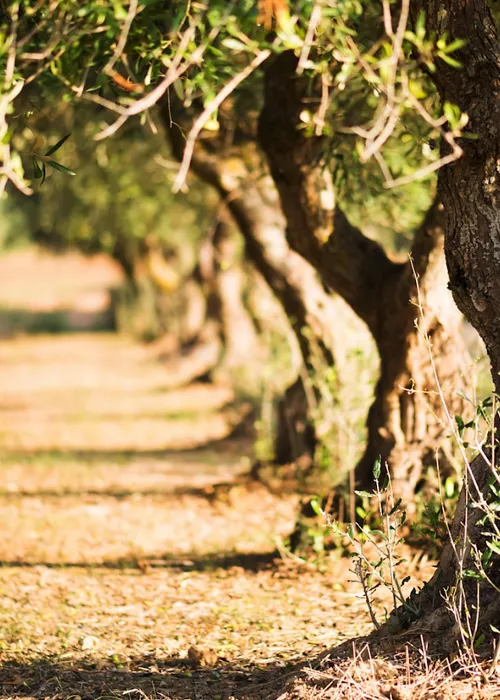
Olive Oil: Apulia's Green Gold
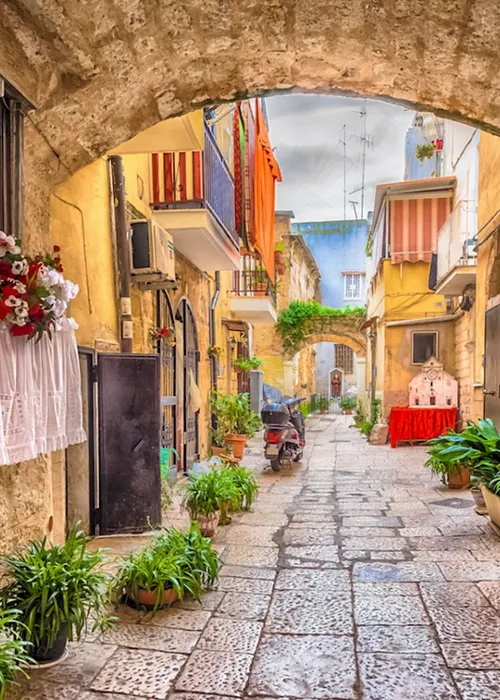
Discovering Bari, an unexpected meeting point between East and West
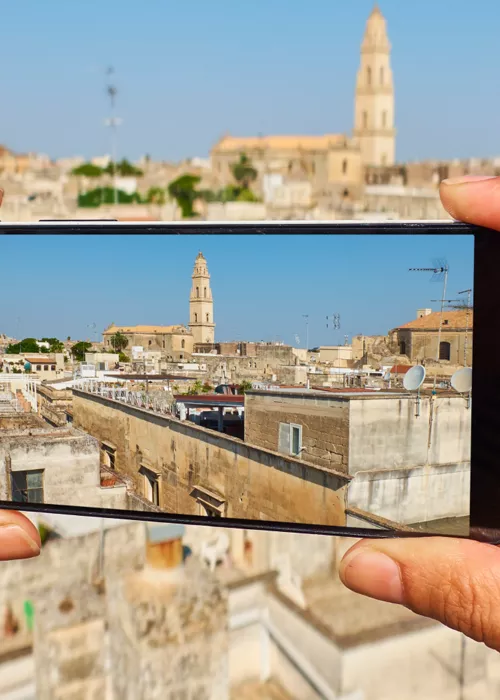
Digitally immerse yourself in the wonders of Apulia
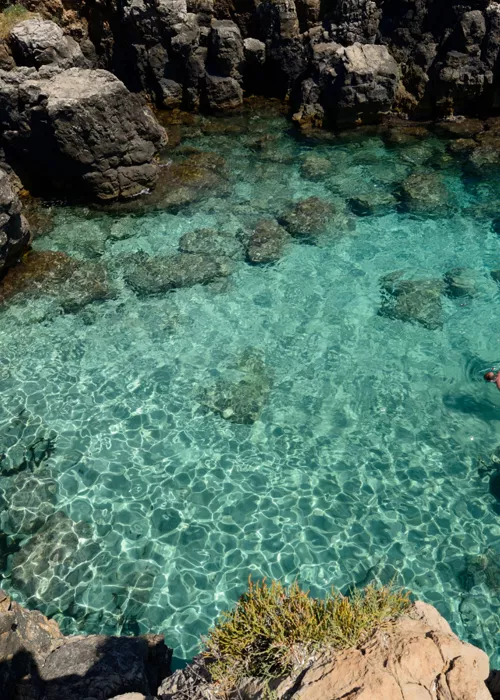
Gallipoli, the pearl of the Ionian Sea
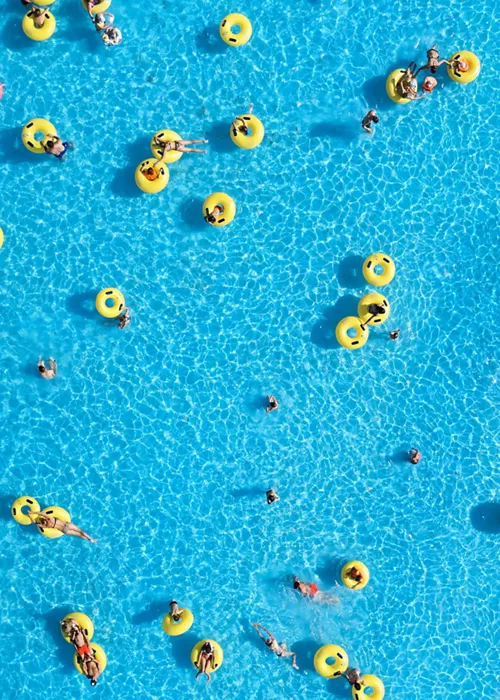
Aquapark Egnazia Puglia, for a day of pure adrenaline in Puglia

The Apulia region by way of Gino Sorbillo’s pizza
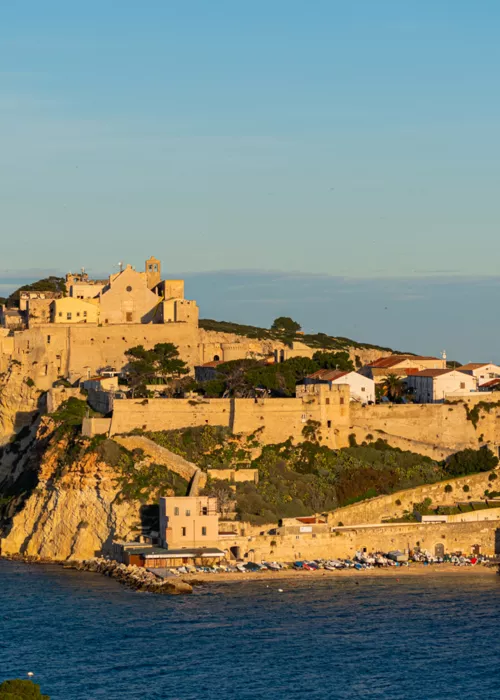
The Tremiti islands can also be visited in winter, think fishing and kayaking
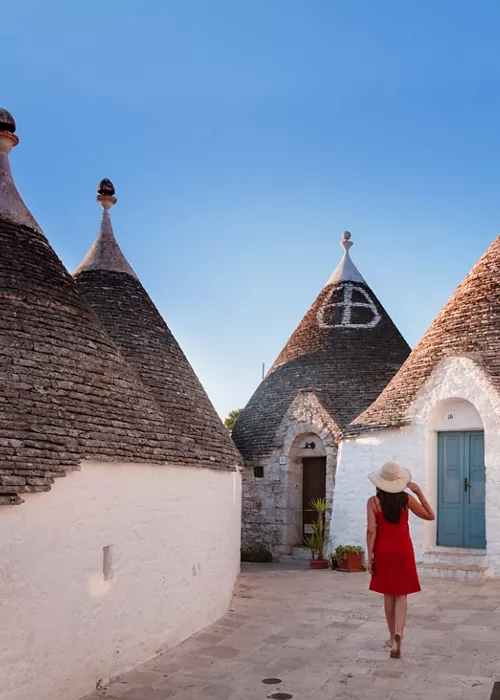
Alberobello, the Trulli capital, a fairy tale experience
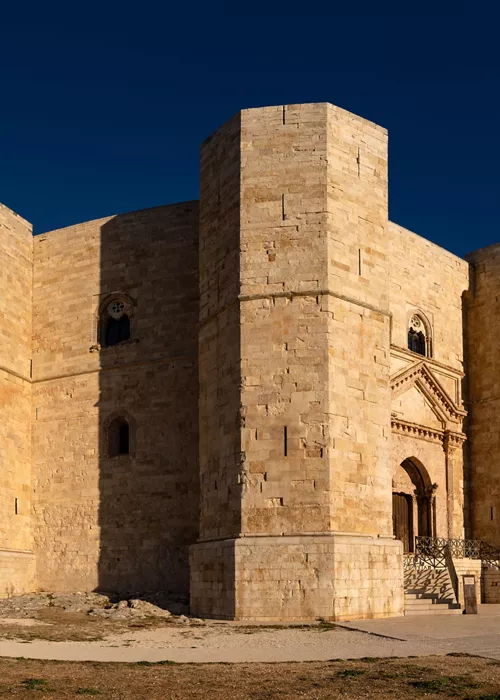
Castel del Monte: the fortress of mysteries in Andria
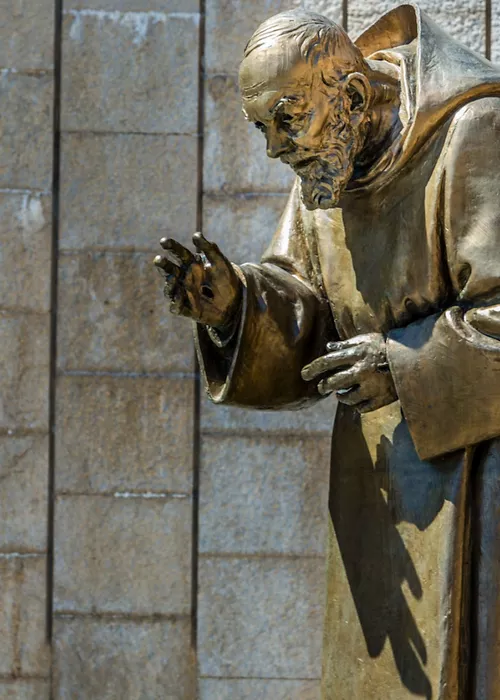
The Sanctuary of Padre Pio
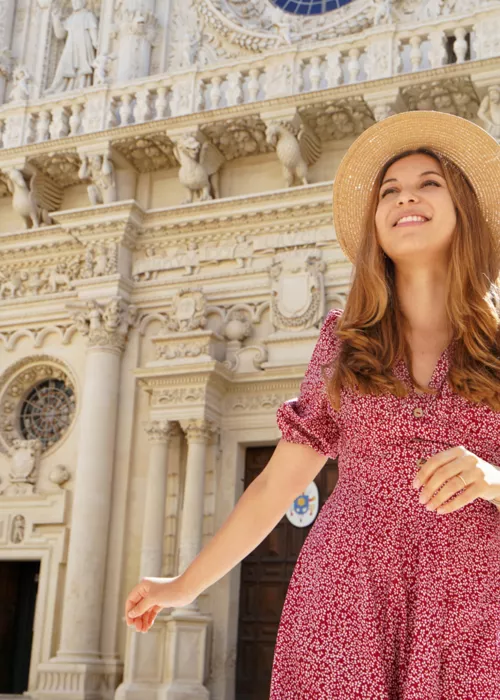
The truest soul of Lecce, with bike tours, cooking classes and home-cooked meals
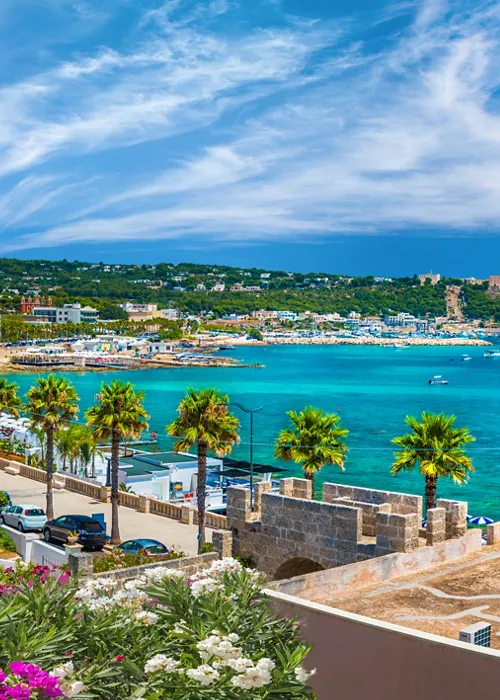
Santa Maria di Leuca
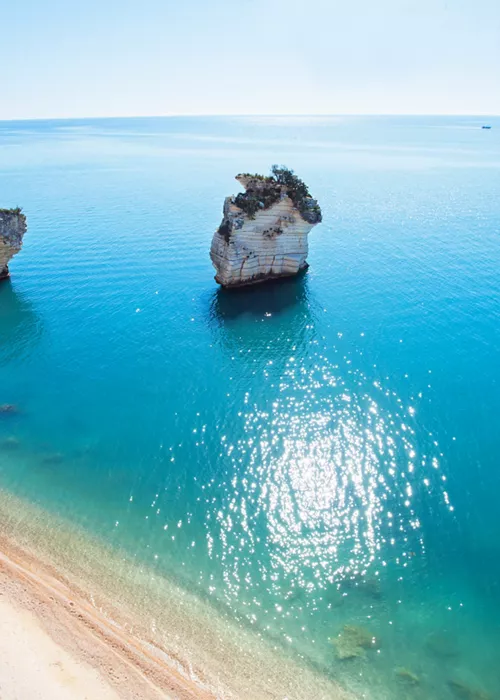
The enchanting crystalline sea of the Zagare Bay in the Gargano district
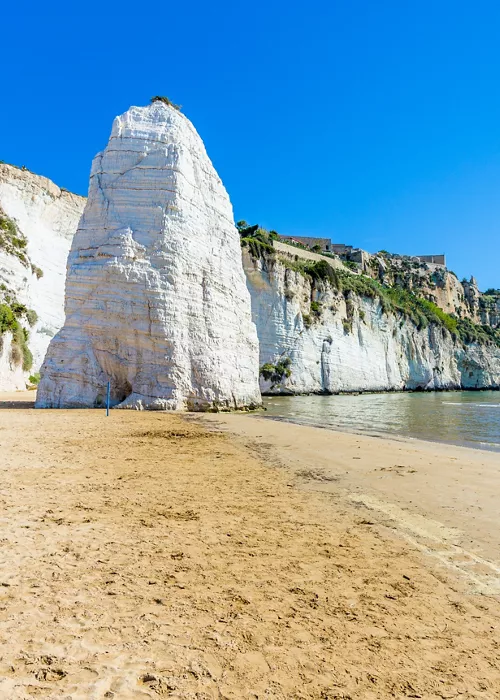
Scialara beach, the number-one location on the Gargano coast
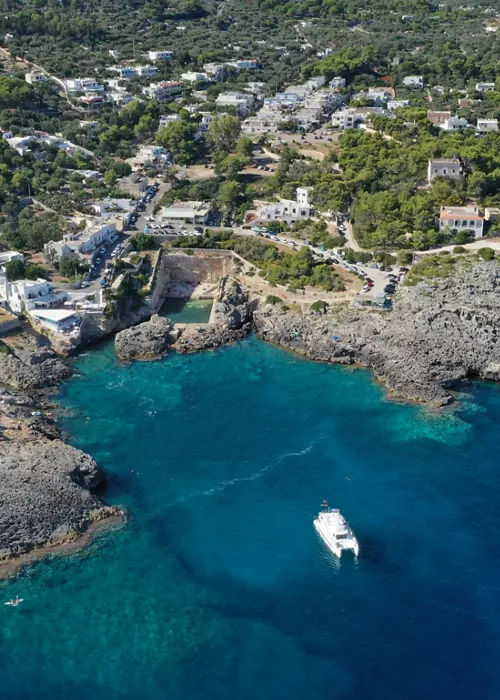
Apulia, pulsing heart of the Mediterranean, cradle of ancient civilisations and with a spectacular sea
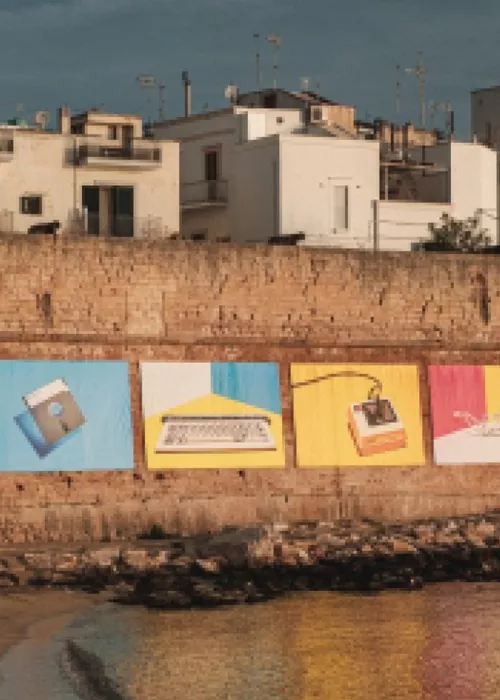
32 locations and 18 exhibitions: PhEST Monopoli enchants with the photography of the future
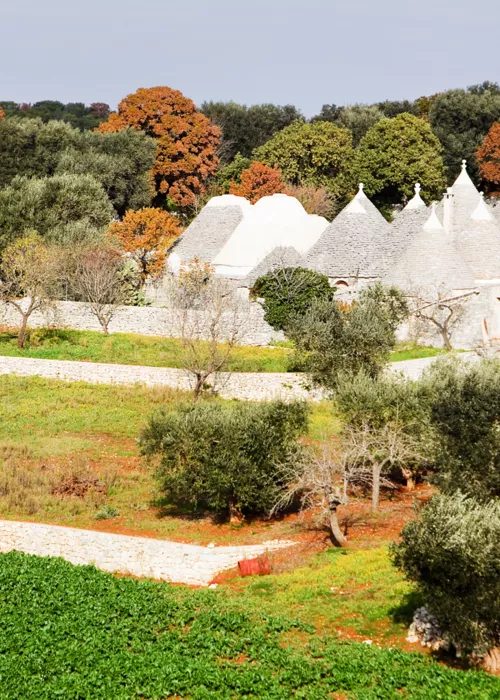
Puglia, an authentic wonder also in autumn

Puglia, all the colours of a top cuisine

Federicus 2024: "Ad Orientem, on the way to the rising sun"

Continue living like an Italian
Subscribe to the Newsletter so as not to miss places, events and experiences for experiencing the best side of Italy: the authentic one.
Keep up to date
Would you like to learn about the most authentic experiences to be had in Italy, stay up to date on the most interesting events, discover our special offers and receive lots of insider hints and tips?
Save your favorite places
Create an account or log in to save your wishlist
Do you already have an account? Sign in

Top ways to experience nearby attractions

Most Recent: Reviews ordered by most recent publish date in descending order.
Detailed Reviews: Reviews ordered by recency and descriptiveness of user-identified themes such as waiting time, length of visit, general tips, and location information.

Zoosafari - All You Need to Know BEFORE You Go (2024)
- Sun - Sat 9:00 am - 2:00 pm
- (0.27 km) Masseria Borgo Ritella
- (0.30 km) Park Hotel Sant'Elia
- (1.14 km) Bed & Breakfast AMATI
- (1.24 km) Masseria Don Sante
- (0.83 km) Miramonti Hotel
- (0.27 km) La Piccola Oasi
- (0.33 km) Masseria pedali
- (1.32 km) Silve
- (0.39 km) Self Service Safari
- (1.34 km) Ardecuore - Trattoria Contemporanea
- (0.25 km) Fasanolandia
- (0.51 km) Sante Benessere
- (1.73 km) The Bikes
- (10.20 km) AllWays Puglia
- (10.38 km) Quad Experience and Emotion

One of the biggest Zoo Safaris in Italy
Fasanolandia
Animals free to roam around, adventure and fun
Fasano owes its noteriety to its Zoo Safari, one of the biggest wildlife parks in Europe and the biggest in Italy for number of specimens. The zoo safari is less than ten minutes by car from Almapetra Trulli Resort. It has been a wildlife park since 1973, and it can provide entertainment for all the family, thanks also to “Fasanolandia” the area of the park dedicated to fun, with 20 attractions to entertain young and old, for an unforgettable day.
The Archaeological Park of Egnazia is another important attraction in the town of Fasano. Made up of numerous finds from the ancient city of Gnathia, the Archaeological Park of Egnazia is on the ancient route between Bari and Brindisi.
The visit to the old farms in the area is not to be missed. We particularly recommend “The Sant’Angelo de’Graecis Farm”, which offers you the chance to emerge yourself in the history of the Fasano area, thanks to the Museum of Olive Oil.
NATURE SPORT AND RELAXATION
For golf lovers, the San Domenico Golf club is situated in Savelletri. It is an 18 hole golf course, with a splendid view over the crystal clear blue of the Adriatic Sea.
For those who prefer relaxation to sport, also in the local area, the well equipped Thermal Centre of Torre Canne is recommended.
Beautiful Puglia
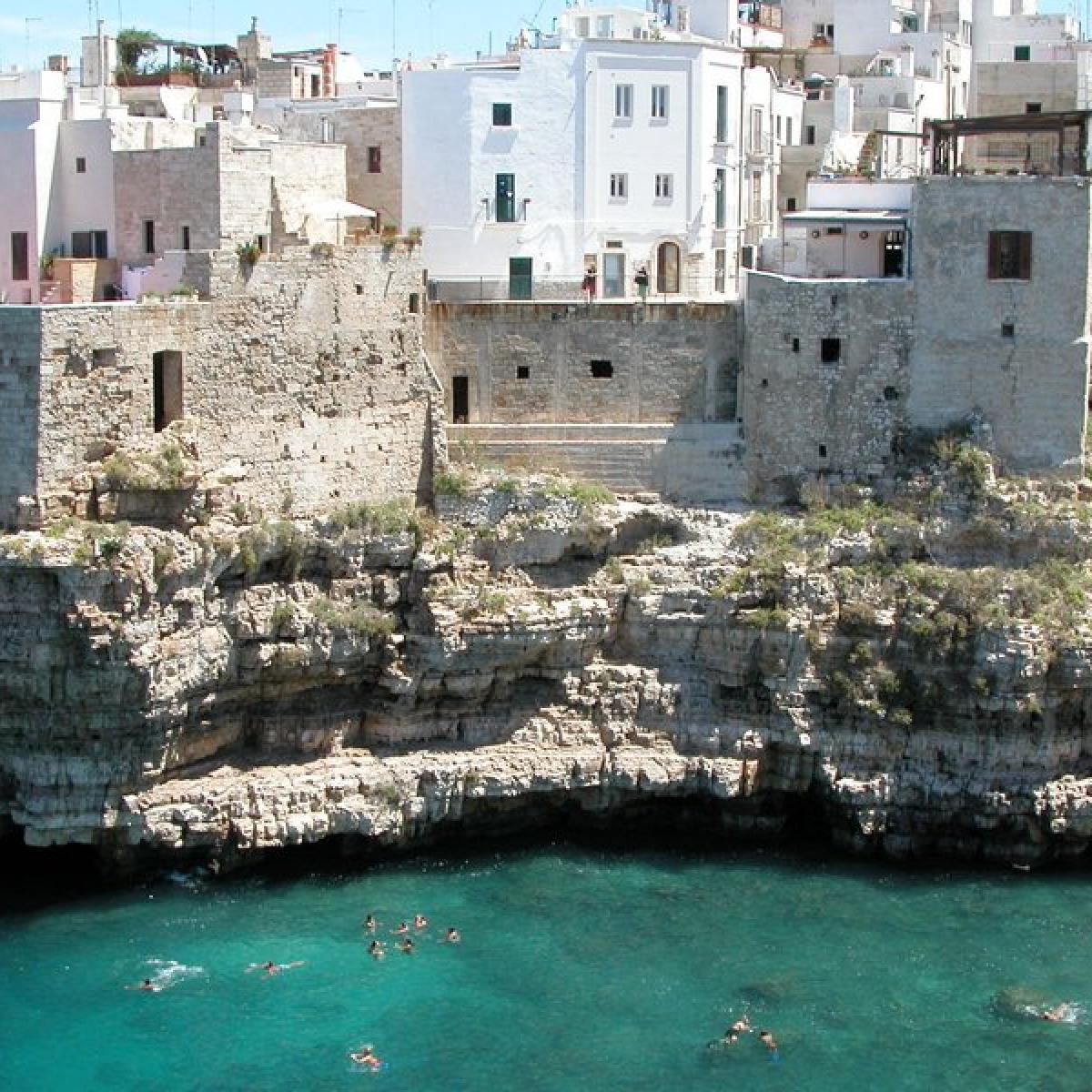
DON'T MISS ALMAPETRA NEWS READ MORE ...
Book your holiday in Puglia

S.C. 160 Contrada Scianna, 8 70010 Locorotodo (BA)
[email protected], (+39) 334 6972409.
About Almapetra Trulli Resort
PRESS REVIEW >
How to get to almapetra.
Almapetra is situated in the heart of the Locorotondo countryside, about 3.5 km from the historical centre of the town. Reaching us by the main means of transport is easy. Discover what the best route is for you.
WHERE WE ARE >
Almapetra Trulli Resort P.I. IT 07793680724 Rea BA - 589885
Cookie Policy | Privacy Policy
Credits: foto di EMANUELECOLABELLO PHOTOGRAPHY©
- Environment
- Kitchen Garden
- Visit to winery
- Visit to Farm
- Visit to the dairy
- The sea of Puglia
- Trip on catamaran
- For Couples
- For families
- Locorotondo
- Alberobello
- Itria Valley
- Martina Franca
- Castellana Gaves
- Polignano a Mare
- Regional Park of the Ravines
- Where we are
Fascino Antico Trulli B&B in Alberobello
Zoo safari fasano.
Zoo Safari Fasano born as a wildlife Park and over the years has diversified its offerings by also focusing on mechanical attractions located in an area that is now in effect become a new park ( Fasanolandia ) and which is described in another tab of this site.
The visit to the Safari Park commits one to three hours ( including pedestrian wildlife departments ) and can also be done individually , without access to the park Fasanolandia . In view of southern Italy is truly one of the best , while presenting some limitations (including organizational ) , especially in the peak days .
Efforts in recent years have been remarkable , and although we can not indicate it as a must-visit park for users of the Centre-North and tourists ( who have the opportunity to visit good facilities at home ) , you have the option to spend , if combined with a visit to Fasanolandia , a whole day of fun for the whole family . Even in 2014 are especially designed 3 different types of ticket, the first is the fauna (the park safari park ) , which is inclusive of all departments animals, visited in part with your vehicle , partly on foot and toy trains ; the second ticket instead provides a less structured and is dedicated exclusively to the amusement park ( Fasanolandia ), the third type of ticket allows access to only Dolphinarium .
Of course this year the exhibitions, museums and educational courses , which are located in the ‘ pedestrian area common to both the zoological park that amusement , you can visit freely with all three types of ticket.
FOR MORE INFO PHONE ZOO SAFARI Fasano : 080 441 4455 1
THE BUSINESS OF ANIMAL PARK ZOOSAFARI INCLUDES:
- Circuit Safari with your vehicle ( even more than the car campers and buses ) to the discovery of lions, tigers, elephants , giraffes , zebras , antelopes and many other animals in absolute freedom Village monkeys ( with train)
- Metrozoo ( train on rails for viewing from above)
- Lake of the Big Mammals ( to meet polar bears, brown bears , rhinos , hippos and seals)
- Zoological pedestrian paths Puppets Entertainment Tropical Hall ( aquarium, reptile , vivarium and shows butterflies )
- Ornithological Exhibition ( live exotic birds , birds of prey from large to small Australian diamonds )
- Nature Trail ( Puglia in Miniature Botanical Trail )
- Exhibitions and Museums
Price 22,00 Euro per adult individual visitors
Reduced price Euro 19,50 for children from 4 to 10 years and by 1.40 meters tall ( free admission for children less than 4 years and less than one meter in height)
Price 15,00 Euro for groups and school bus of at least 29 paying persons 2 )
THE BUSINESS OF AMUSEMENT PARK FASANOLANDIA INCLUDES:
- Pedestrian entrance to Fasanolandia 6 attractions in choice ( between rides and 4D cinema )
- Nature Trail ( Puglia in Miniature and Botanical Trail )
Price 8,00 Euro for individual visitors ( FULL )
Price 5,00 Euro for groups and school bus of at least 29 paying persons
Price 5,00 Euro for holders of coupons
DELFINARIO – ACADEMIC PERFORMANCE WITH DOLPHINS
Prices for single input Bal dolphins (if not in possession of a ticket or Zoosafari Fasanolandia ) :
Adults : 12,00 Euro Children ( from 1m to 1.20m)
10,00 Euro School groups : € 8.00 Prices for ticket holders Zoosafari or Fasanolandia
Adults : 10,00 Euro Children ( from 1m to 1.20m)
Euro 8,00 Groups and schools
6,00 Euro Free admission for children under one meter tall.
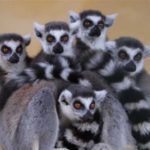
Magnets On The Fridge
Self-planning vacationers exploring the world
Zoosafari Fasano – a drive-through zoo in South-Italy
We have stopped our car and ostriches are circling us. They are knocking on the windshield with very awaiting looks on their faces. Their beaks look quite intimidating and they are staring us. Can they crack our car window? They seem to be expecting some food, but we don’t have anything to give them … so we decide to take selfies with them instead.
How we got here?
We were on our way from Torre Santa Sabina to Alberobello when we saw a Zoosafari Fasano sign. The sign itself didn’t give away much- there were only a name “Zoosafari” and distance. But it caught our attention.
We couldn’t find much information from the Internet, but enough to be interested. We had never been in this kind of zoo. Ticket costs 25€ for adult and 21€ for children and will include also a visit to a regular zoo, to monkey ride and to a tropical house, but it still seemed to be a lot. But it really was worth it! It is a quite unique experience- basically, you will drive through the zoo with your own car.
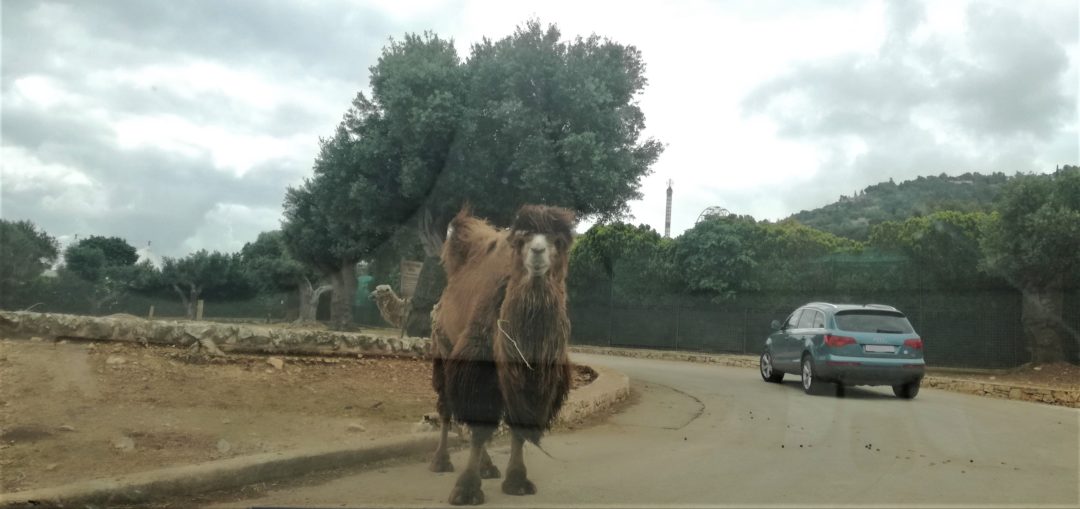
Driving trough Zoosafari Fasano
The whole zoo is separated into two main parts. The safari section for driving and regular zoo. Safari part was a really cool and up-close experience. Animals there looked friendly, happy, playful and very used to the vehicles passing by. They came close and were very interested in us. Ok- not exactly us. They probably expected to get some food.
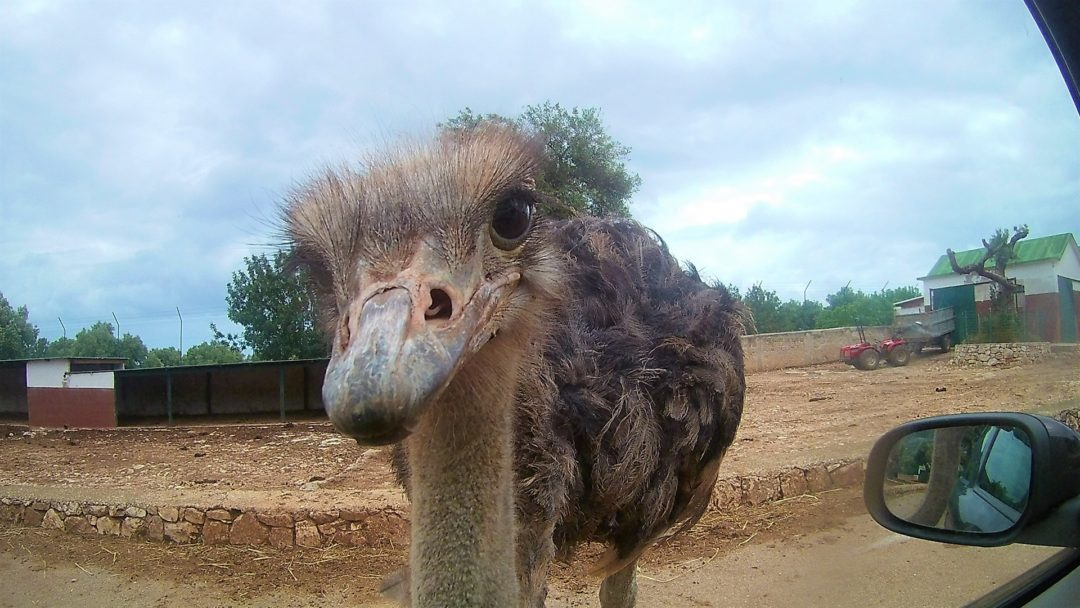
Animals are separated with fences between different areas. Lions, tigers, and bears have their own dedicated areas where it is forbidden to open a window. But to be honest- it even didn’t came to our minds to open car windows in the lion cage. Double gates are between those areas which are manually operated. You have to drive through the first gate and wait until that closes. After that man in the booth opens the next one and you can move on.
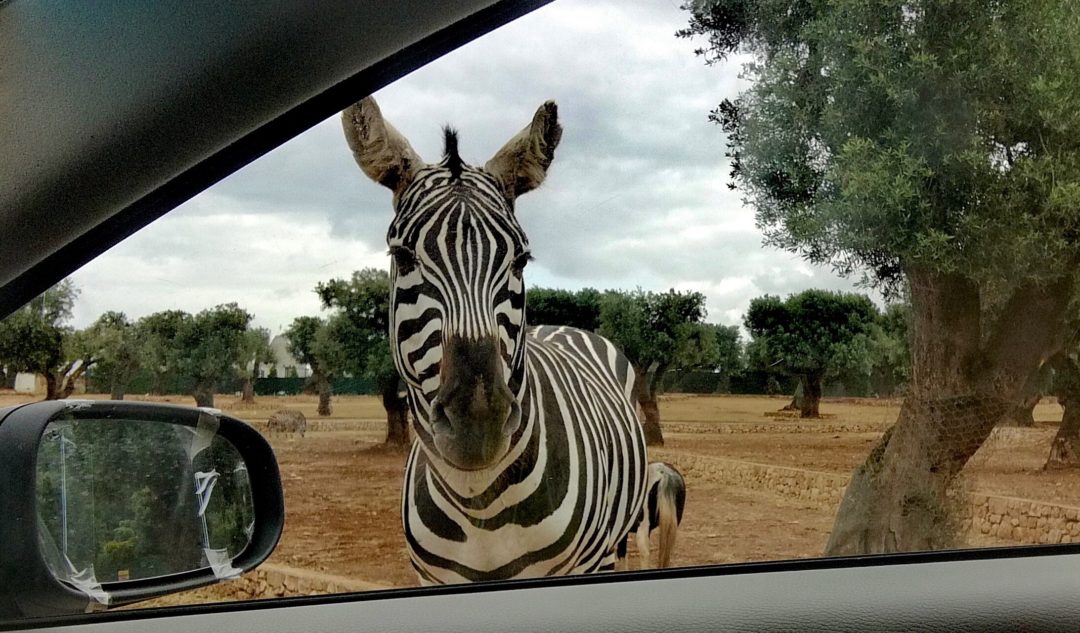
All other animals are kept less strictly separated. Must be based on which ones get along each other naturally. Basically, they live freely – so don’t be surprised if you will find goats sleeping on the road or an ostrich knocking to the window. You can let down your window and pet the animals if you want.
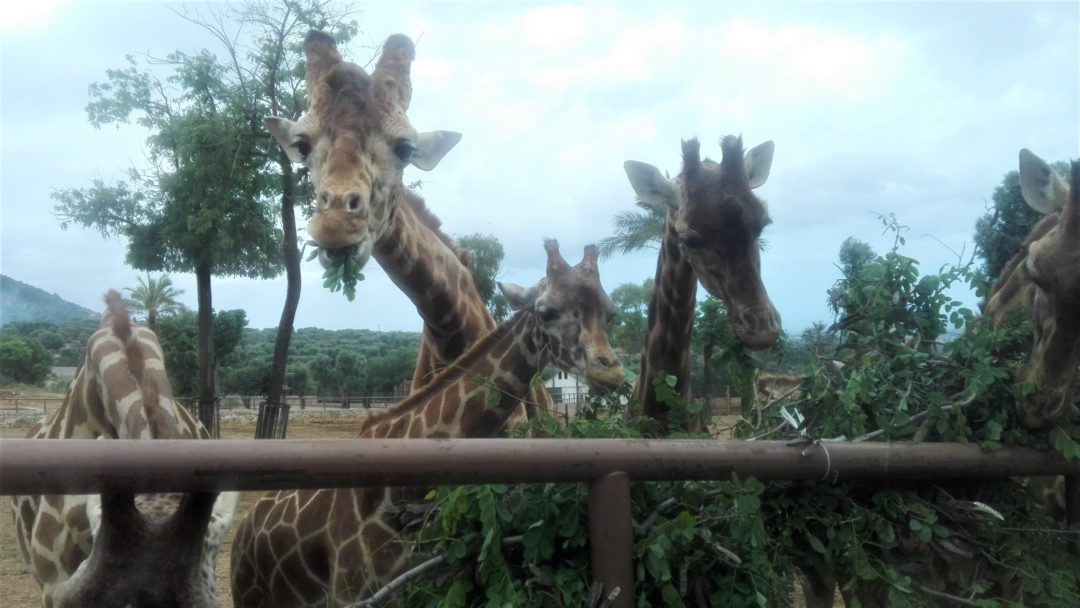
We hoped to see lions up close and around the car, but unfortunately, they were relaxing on the grass. Far away from the road and not interested of us, which was a pity. They were just watching us from the distance. Same with bears and tigers. We caught them after feeding probably.
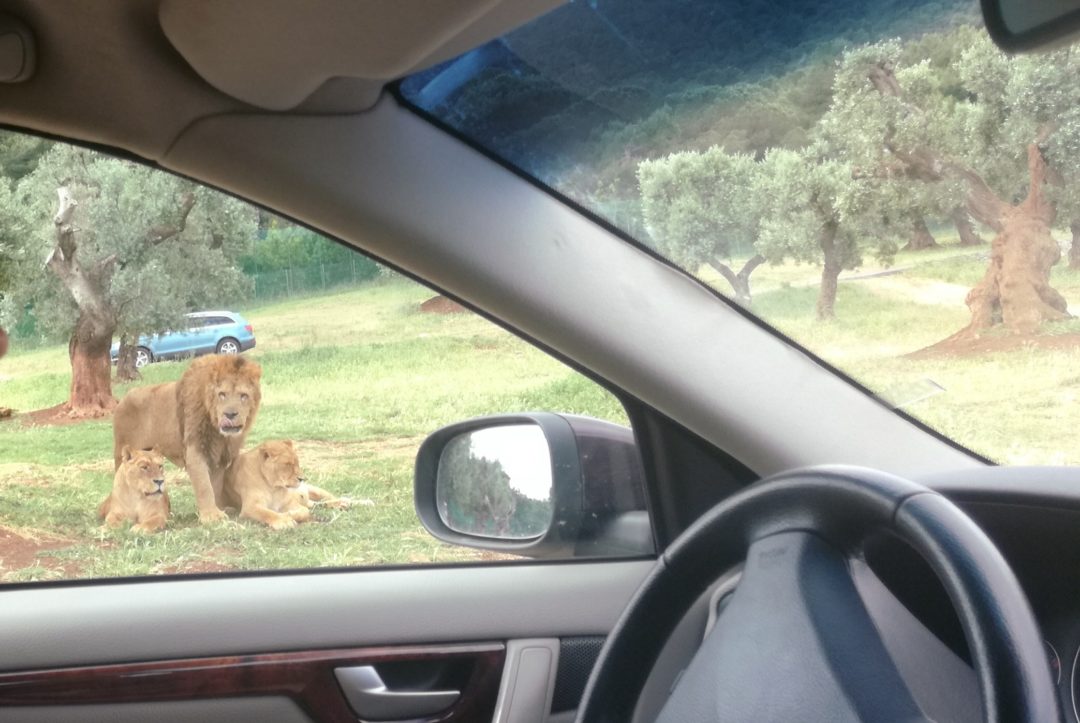
Regular zoo
After you will finish with the safari part, you can park your car outside of the park and go visit the pedestrian zoo. We used the parking lot on the left after exiting safari. Parking did cost around 3€ in 2018.
The regular zoo is also separated into different areas and it also features a theme park which altogether makes up “Fasanolandia” park. Some of the examples are monkeys cage, tropical house, dolphinarium and the lake for the large mammals like sea lions. They also provide dolphins, penguins and sea lions shows for visitors at various times each day. This is at extra cost.

People in the cage
In Zoosafari Fasano you can swap position with animals. You have the possibility to go inside of the monkey cage- but for that, you have to get on to the train and into the cage. This was a really unique experience- some monkeys were riding with us on the top of the train and checking us out through the metal grid. Others were just having their normal life- grooming, eating or taking care of the babies.
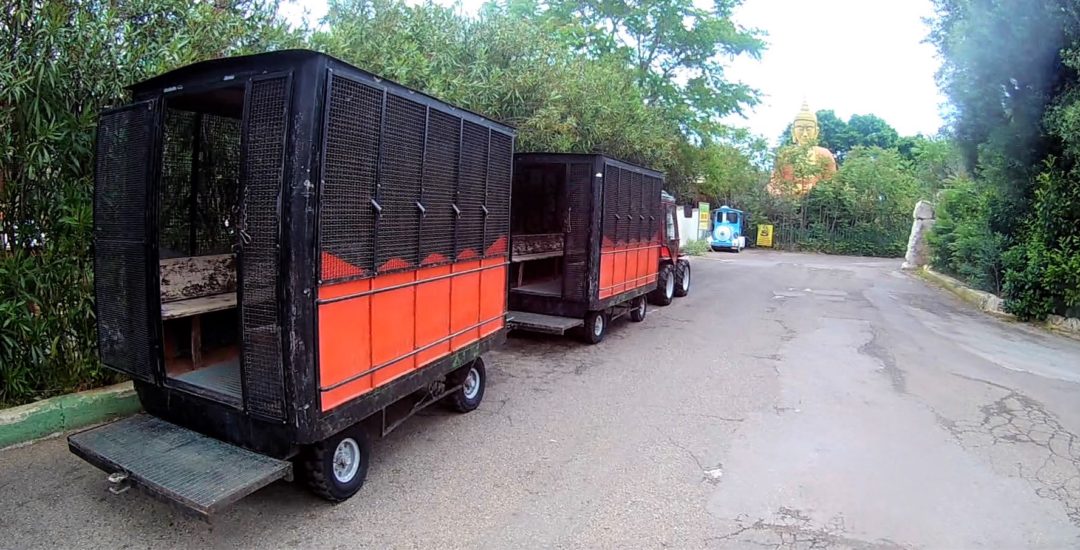
Questions we had before going to Zoosafari Fasano
We had many questions before going to the zoo safari. It was not quite clear for us how the exact visit will look like, is there a time limit for driving etc. Here are some of the questions answered.
Is there room to let other drivers pass you?
Yes. The roads are quite wide so you don’t have to worry about that. Driving is done in one direction – no oncoming traffic either. Even a tour bus was able to pass us. After we saw how this tour bus rushed through the safari, we were glad that we were there with our own car. It left us the liberty to decide how much time we wanted to spend looking at the specific animals. Bus variant must be pretty boring for visitor.
How fast I have to drive through the zoo safari?
There is no strict time limit so you don’t have to rush through the zoo. Also, there is no speed limit nor time restrictions as we did understand. But the recommended maximum time was about 90 minutes. It’s plenty of time to look at the animals and take the selfies. We were totally able to keep our own pace and take as long as we wanted.
Since we visited Zoosafari Fasano in the middle of the week in April, there were not many other cars around. When we looked this place up in Google Maps we saw that it can be worse. But at the same time, you can see some cars and buses passing the row. Google maps link here .
How can I get a ticket? Should we park our car first or should we drive directly to the ticket office?
You can drive directly to the ticket office at the main entrance, purchase your ticket, and then drive directly to the safari. After you have finished the safari road, you can park your car, and walk to the pedestrian zoo. A parking lot will cost 3€ and it has a nice shadow on the top.
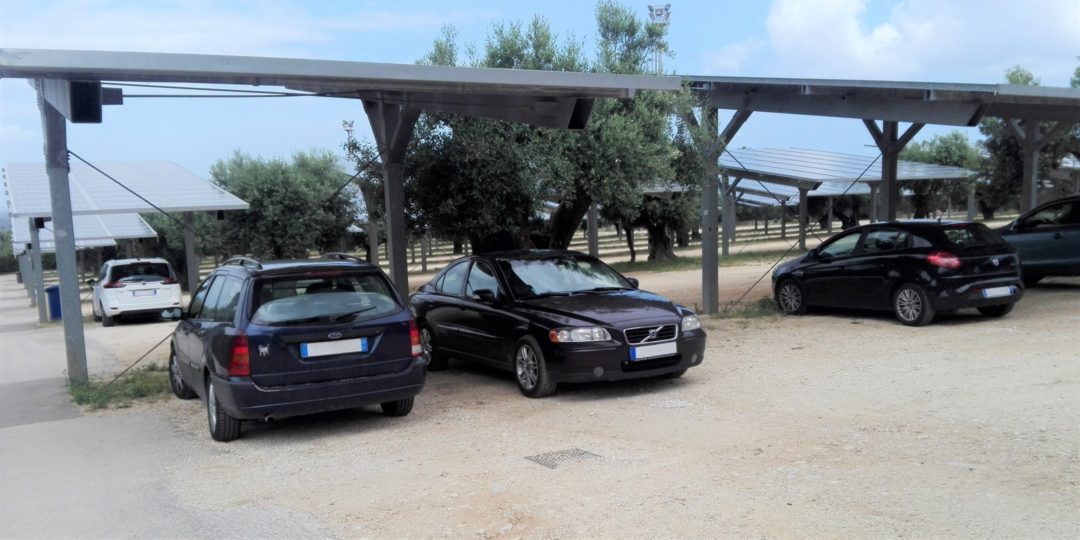
Can I feed the animals?
Obviously, animals are used to get snacks from visitors since they gather around cars. We wonder if people would not give them food- would the experience actually be less attractive and animals would not come close? At the first gate, there was a sign that states that it’s forbidden to give food to the animals.
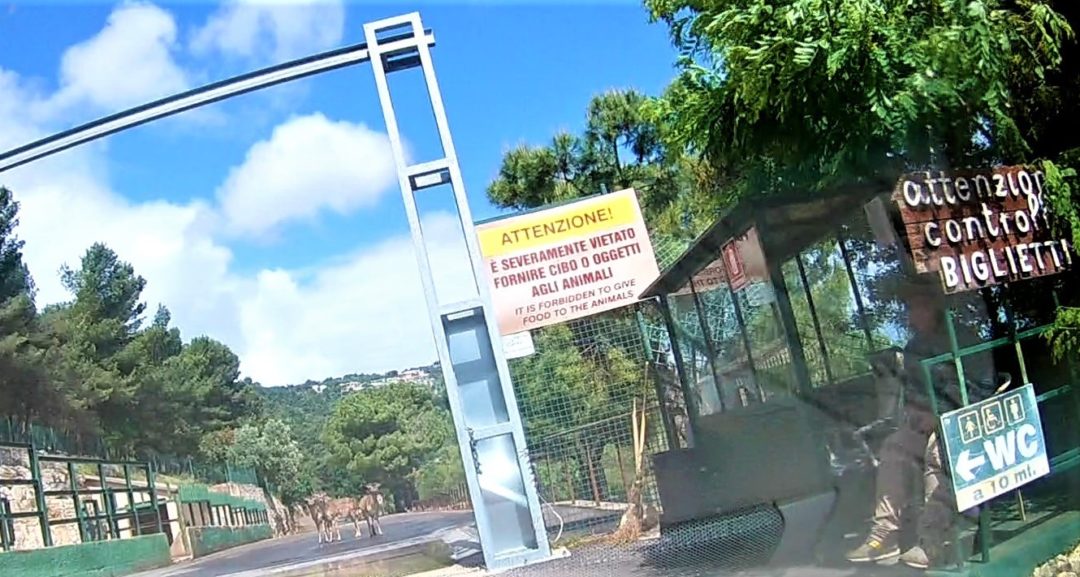
Was worth it!
Our overall experience was great and we were pleased. It might be due to it’s our first time visiting such zoo. Janar usually doesn’t like zoos because of animals seem to be not happy in them. It’s not the case in Z oosafari Fasano- especially in safari part. We would totally recommend visiting this- although it could get pretty pricey for families.
The home page of the Zoosafari Fasano is http://www.zoosafari.it/
PS: If you are looking for a place where to have lunch and you wouldn’t mind driving a few kilometers, then we would recommend Ristorante La Grande Quercia . It is 4 km (10 minutes) drive from Zoosafari Fasano. We read some really good reviews about their pizza, but unfortunately, they are serving pizzas only in the evenings. But the pasta we tried was also really good! And the best part is, that it seemed to be a real authentic Italian restaurant where also the locals will eat.
Leave a Reply Cancel reply
Your email address will not be published. Required fields are marked *
Save my name, email, and website in this browser for the next time I comment.
Math Captcha − 2 = 1
Percorribile in auto, in bus e in camper
Area safari.
Tutti pronti? Inizia l’avventura! Superato l’ingresso l’adrenalina sale: pochi metri e si dischiude un vero incanto della natura. Qui i piccoli potranno incontrare tutti gli animali di cui hanno conoscenza attraverso i racconti. Ecco lì un gruppo di tigri sonnecchiare all’ombra di un carrubo, il cammello dall’andatura dondolante, il potente ruggito del leone. Oh, guarda, le altissime giraffe, le zebre e le gazzelle, gli struzzi dagli occhi curiosi e i pigri orsi. E poi, all’improvviso gli imponenti elefanti e i massicci rinoceronti. Che meraviglia…
Orario di apertura dell'area Safari
- Marzo (ven, sab e dom) 10:00 - 14:00 (ultimo ingresso)
- Aprile - Settembre (tutti i giorni) 9:30 - 15:00 (ultimo ingresso)
- Per gli altri mesi consultare il calendario
Faq principali
Avvisi importanti.
Non uscire dalle auto
Non dare da mangiare agli animali
Non fermarsi durante il tragitto
In caso di problemi con l'auto restate in macchina
Gli amici animali
Fenicottero, zebra di grant, elefante asiatico, elefante africano, orso dal collare, rinoceronte, asino somalo, gazzella di mohrr.
- Panoramica privacy
- Cookie strettamente necessari
- Cookie di terze parti
- Cookie Policy
Questo sito Web utilizza i cookie in modo che possiamo fornirti la migliore esperienza utente possibile. Le informazioni sui cookie sono memorizzate nel tuo browser ed eseguono funzioni come riconoscerti quando ritorni sul nostro sito Web, e permetti di aiutare il nostro team a capire quali sezioni del sito Web trovi più interessanti e utili.
I cookie strettamente necessari dovrebbero essere sempre attivati per poter salvare le tue preferenze per le impostazioni dei cookie.
Se disabiliti questo cookie, non saremo in grado di salvare le tue preferenze. Ciò significa che ogni volta che visiti questo sito web dovrai abilitare o disabilitare nuovamente i cookie.
Questo sito utilizza sistemi di analisi per raccogliere informazioni anonime come il numero di visitatori, e le pagine più visitate.
Mantenendo questi cookie attivi, ci permetterai di migliorare il sito e di offrirti un servizio migliore.
Attiva i cookie strettamente necessari così da poter salvare le tue preferenze!
Maggiori informazioni sulla nostra pagina della Cookie e Privacy Policy
- Blog Archives
- Copyright | Cookie policy
- Literature
- (V)IPs Zoos
- Rest of the World
- Endangered Species
- Species Classification
- (V)IPs Evolution
- Latest Newsletter
- Newsletter Archive
- Subscription
- Video Gallery
Select a Zoo
Reviews — zoos in europe, history description, history documentary.
During the second half of the nineteenth century the first menageries in Moscow were established as entertainment facilities. The first was founded in 1855 by two Frenchmen (names unknown), while the Kreuzberg family owned a private menagerie that opened its door to the public in 1862 . Together these animal collections formed the heart of the Moscow Zoological Garden founded by the Society for Acclimatization of Plants and Animals, which was established by professors of the Moscow State University. The initial idea for such a zoological garden came in 1857 , but it took the Society, including one of its founding fathers professor Anatoly P. Bogdanov, until 1863 to be able to buy property for the future zoo. The Zoo was opened to visitors on 13 February 1864 at the location where it still exists until this very day. On opening day 287 animals were on display, of which 134 were domestic animals, while the others were exotic specimens such as tigers, lions, jaguar, leopard and rhino.
In those days it was an unique experiment to create “a living museum outdoors,” as professor Bogdanov said, in such severe climatic conditions of central Russia. The primary purpose of the Zoological Garden according to the members of the Society was:
to collect alive specimens of higher vertebrates ( firstly — the animals of Russian fauna) for scientific observations;
to establish a collection of typical animals that could serve educational purposes, i.e. distribution of zoological knowledge among the wide public communities;
to carry out scientific experiments and observations of important animals, especially domestic animals of Russian breeds.
The Zoo was financed by the entrance fees and private donations, including contributions by members of the imperial family. In the first years the annual number of visitors grew up to ten thousands. Nevertheless, the incomes did not cover the expenses and the Moscow City Council refused to give financial support. So, the Zoo went into private hands of the Ryabinins’ family in 1874 . They transformed the Zoo into an amusement park and in three years time ruined the place. In 1878 the Zoo was run by the Society for Acclimatization of Plants and Animals again, including fund raising activities. This time the Society was able to manage the Zoo successfully, and even to buy a number of animals. But in the turmoil of the Revolution of 1905 the Zoo was severely damaged: the buildings were ruined, the library was set on fire, many animals perished. So, for the second time the Society was forced to turn over the Zoo to private owners.
Then in 1914 World War I broke out. For the Zoo this meant that in the autumn of 1914 the only building that remain to this day was transformed from the director’s premises to a hospital for wounded WWI soldiers. The WWI impact compounded Russia’s suffering from a number of economic and social problems, which resulted first in the 1917 February revolution followed by the October revolution. In the aftermath of the Great October Socialist Revolution of 1917 and the fall of the Russian Empire, the Society ceased to exist, and in 1919 the Zoological Garden was declared national property and transferred under the responsibility of the ministry of Culture of the communist Moscow parliament, the Mossovet. In 1922 it was transferred to the authority of Moscow City Council and since then it has been supported by the City Authorities. Construction work began on the Zoo grounds. The Zoological Garden premises almost doubled in size with the establishment of the ‘New’ territory on the opposite side of Bolshaya Gruzinskaya street. New exhibits, which followed the principle of Carl Hagenbeck’s bar-less enclosure design were established. One of the most interesting exhibits of the Zoo called ‘Animal Island’ still exists. It was a high stony rock surrounded by a deep water ditch that separated the visitors from bears, tigers, lions and other large predators on the ‘Island’. The total size at the time was nearly 18 hectares.
In 1926 the Zoological Garden was renamed ‘Zoological Park’. At that time the range of activities extended, the animal collection increased considerably with expeditions collecting wildlife in Central Asia, the Far East and the Caucasus. New departments were established, focussed on for instance scientific research, education, veterinary science and nutrition. In those same years Moscow Zoo was the first zoo in the world where educational activities were the main priority.
In 1924 the Zoo had established the Young Biologists Club that gathered like-minded young people that joined in real scientific research. Many of them became a Zoo employee. The Club was founded by Petr Manteifel, who also was the pioneer father of the science called ‘zoo biology’. Manteifel and his young biologists discovered a way of artificial breeding sables (Martes zibellina), which were on the verge of extinction due to man’s insatiable pursuit for its expensive fur. In the 1930 s during Stalin’s great purge many members of the Young Biologists Club were arrested accused of spreading anti-soviet propaganda and liberal-minded ideas and having contact with German colleagues at Berlin zoo, some were even executed as foreign spies. The Club was considered a non-governmental organisation beyond the direct control of the authorities, which in fact was partly true because the Club was a real democracy, with membership available to all.
Although many animals were evacuated and many of the zoo staff were called to arms at the beginning of World War II the Zoo was kept open. Of the 750 employees at autumn 1941 only 220 remained on the staff, most of them women. Getting enough food for the animals was a constant challenge, for instance carcasses of killed horse at the battlefield around Moscow were brought to the zoo. More than six million people visited the Zoo from 1941 to 1945 to enjoy the sights of animals that had remained.
At wartime the scientific work proceeded, perhaps even more intense than before or after the war. The scientific staff worked especially on development of antibiotics. But the most important mission of the Zoo during the war was to give people hope. It produced the illusion of a peaceful life until people survived through the desperation of the war with the Red Army soldiers as the most frequent visitors of the Zoo. Which were given the pleasure of watching newborn offspring even during the war.
During the soviet union period ( 1922 − 1991 ) not many highly ranked people cared about the zoo — no soviet leader had any interest in it. The city encroached on the zoo premises, while the zoo needed additional space for the ever expanding zoo population of animals. Because the breeding results were still excellent.
The Zoo lived up to the goal it had set for itself and made educational activities the main priority. Zoo staff distributed knowledge in the field of natural history and tried to raise the public awareness and concern about the necessity for wildlife conservation. The zoo assisted schoolchildren and students with studying biology, actively participated in scientific research, and actively contributed to scientific publications. So, the Zoo became one of the larger scientific institutions in Moscow. And of course it still was the favourite recreational place for Moscow citizens and those who visited the city.
As off 1974 when Igos Sosnovsky retired as director and his successor Vladimir Spitsyn took over Moscow Zoo became part of the international zoo community again. Sosnovsky as a WWII veteran hadn’t been able to brush aside the fear of repression and avoided all international contacts for some reason. Spitsyn restored all international activities from before the war and the Zoo became member of many European and International Breeding Programmes in which it exchanged its rare and endangered animals, shared experience and information.
Although already in the 1970 s improvement of all zoo facilities was needed and ideas of a new zoo in another region of Moscow were launched, nothing happened due to local economical and social problems. By the end of the 1980 s the Zoo’s condition became alarming. Facilities were deteriorating, enclosures were dilapidated and technical equipment needed to be replaced as well. And while a few improvements had been achieved — such as a partial renovation of the main entrance, the monkey house and lion house — urgent measures were still needed.
Then, in 1992 the new Moscow government made a decision to start the most ambitious reconstruction project in Moscow Zoo’s history with the first stage of the project to be completed by 1997 , when the 850 th anniversary of the City would be celebrated. Anatoly A. Andreev who had been involved in the Zoo’s design and architecture since the 1970 s headed the team of architects. The project’s renovation objectives were focussed at (a) preservation or partial renovation of the historically valuable buildings and existing pools, (b) reduction of the noise from the surrounding streets, © connection of the Old and the New territory via a footbridge, and (d) expansion of the Old territory by incorporating adjacent areas and buildings.
Besides the preservation and renovation of almost all important zoo constructions, including the ones that actually were dilapidated, many new enclosures and facilities were built. Already in 1993 the footbridge that connected the Old and New territory was completed. It allowed visitors to avoid crossing the busy B. Gruzinskaya street with its heavy traffic. In 1993 other constructions were completed as well, such as an enclosure for large birds of prey and a complex of enclosures for feline species, including leopards, Pallas’ cats and lynx. Next, the Hagenbeck-style ‘Animal Island’, one of the most remarkable exhibits in the New territory, was renovated. The historic appearance with enclosures that resembled the natural habitats of Amur tiger, striped hyena, African wild dog and Asian black bear was preserved. Later they introduced Asian lions in one of the enclosures around the large rock in the centre of the ‘island’. During the renovation they created the Exotarium, which held several aquariums, inside the rock on the second floor.
The following years many more enclosures were renovated, besides the new research and veterinarian facilities that were put into operation in 1994 . In 1996 , the main entrance itself (featuring a small artificial waterfall) was reconstructed. The same year the old, dilapidated elephant complex was demolished and a new elephant house was erected at the same spot, while the inhabitants (four African elephants and four Asian elephants) were temporarily moved to a a former tram depot that was completely renovated and specially equipped. A new children’s zoo was opened in the New territory, including a children’s theatre that organises shows with educational elements. And besides several aviaries, a pavilion for water birds was built on the shore of the large pond in the New territory.
Although in those days 4 additional hectares of space was added to the former existing 18 hectares, the Zoo still lacked space to create favourable conditions for their species to breed. And its location in the centre of Moscow didn’t contribute to the favourable breeding conditions they wanted of course. Therefore, the 200 hectares area near the city of Volokolamsk (about 100 km from Moscow) that was given to the Zoo in 1996 for the establishment of a breeding station was very much welcomed (see also Breeding Centre ).
The first major stage of the general reconstruction of the Moscow zoo represents a unique event. Not only over 50 facilities have been renovated ( 90 % of all existing facilities) and newly built, but it was achieved in such a short period of time. But maintenance and small and larger refurbishment is ongoing business in a zoo. So, i n 2002 , the Moscow City Government and the City Council allocated the necessary funds to start construction of a new pavilion for the Asian elephants. In 2003 the three elephants could move house already, and in spring 2009 , the first newborn elephant calf was welcomed.
The Moscow Zoological Park has come a long way from the small zoological garden it was to the large institution of scientific research, education, conservation and recreation it is today. And due to the dynamics of the standards used in the zoo community regarding animal health and welfare, Moscow Zoo is constantly improving its facilities, also during 2014 celebrating its 150 th anniversary.
(Source: Moscow Zoo website; Zoo with a Human Face, to the 150 th anniversary of the Moscow Zoo — a documentary by Darya Violina and Sergei Pavlovsky, 2014 ; Zoo and Aquarium History by Vernon N. Kisling, Jr., 2001 ; Wikipedia)
An account of 150 years of history of the Moscow Zoo
(A documentary by Darya Violina and Sergei Pavlovsky)
The history of Moscow Zoo shown through the perspective of the lives of the people who have been important to the Zoo’s development and continuous progress over those many years since 1864 . Thousands of photographs, hundreds of chronicles, accounts and recollections that have preserved the story that began so long ago, against all odds, and lasts uninterrupted to this day. A documentary about those who have devoted their lives to serving a noble and rewarding cause, those who have started from scratch, those who maintained that work and about those who revive the Zoo as off today.
(Source: sdpavlovskiy YouTube channel)
20 . 06 . 2014
Finally, Moscow Zoo is paid a visit. I have been looking forward to this for quite some time. It has been on my to-do list since I learnt about the large collection of feline species on display at the Zoo. So, I am here on this sunny day in June to satisfy my curiosity, in the year they celebrate the Zoo’s 150 th anniversary.
I am entering as one of the 1 , 5 million paying attendance yearly. Which is not even half of the total number of visitors a year. This is about 4 million, because there are specific categories (e.g. disabled, pensioners, children, students, etc.) for whom the admission is free.
OLD TERRITORY
I turn left after the main entrance to visit the large predator section of the Old territory. Not that only here you will find predators, but the greatest part of their predator collection is grouped in this section. I will come back to the grouping of Moscow Zoo’s animal collection later. After having walked along a fence that blocks most of the views on the work in progress at the lake I arrive at what they call here the ‘tropical cats’ section: Bengal tiger (unfortunately the genetically aberrant version — a white tiger), jaguar and cheetah. Both the tiger and the jaguar have their indoor enclosures in the same house built at the perimeter of the premises. The cheetahs have their shelter for the night and bad weather in their outdoor paddock, so that cannot be visited. The tiger and the jaguar however have interesting housing that serves the needs for both the cats and the visitors. The latter are pleased with Asian and South American (Inca) ornaments to make sure they understand the geographical origin of the species. While the walls have murals representing the species’ original habitat … Machu Pichu for the jaguar. The animals themselves have various enrichment features at their disposal, including high level observation posts, in rather small exhibits. The outdoor facilities for these two species are accessible from the indoors. It has natural vegetation, but not a lot. Likewise there are not a lot of options to shelter from extreme weather or loud crowds. Although the cats have access to several resting posts at different levels, these enclosures can do with some improvements — at least more vegetation — to make them better fit for purpose, in my opinion. The enormous exposure of the cats is also due to the fact that they use windows to separate animal from man along almost the total length of the enclosures.
When I walk the few steps to the entrance of the Bear House, which is like the jaguar and tiger indoor enclosure built at the edge of the Zoo grounds, I pass in between the Pallas’ cat exhibit and a second jaguar exhibit. The Pallas’ cat has a flat grassy area with three large trees, some shrubs and a potential pond (when filled with water) available in its outdoor enclosure. Windows all around and a wire mesh roof prevent the cat from fleeing this scenery that doesn’t resemble the cat’s original Himalyan habitat. Across the footpath there’s a jaguar enclosure that’s more interesting than the one directly neighbouring the tiger. This one has a small stream and loads of vegetation and a multilevel resting platform. Still the animal is quite exposed.
The Bear House provides a nice and secluded area where three adjacent bear enclosures houses sloth bear and spectacled bear. As a visitor you walk via a roofed corridor more or less in the dark along the enclosures having good views on the exhibit via man-sized windows. The enclosures have a dry shallow moat at the visitor’s side, but I don’t think this withhold the bears from coming close to the windows. The enclosures are small but almost completely filled with enrichment features including various platforms, a tree trunk structure, rubber hammocks and natural vegetation. Considering the design I think these enclosures offer peace and quiet for the bears, unless people start banging the windows of course.
In slightly larger enclosures they keep Amur leopard, snow leopard and cougar ( Puma concolor ). At all of these felid species enclosures the distance between the public barrier and the fence does allow contact when people lean far forward.
Further along the footpath around the corner the arctic fox and the dhole are housed in enclosures that have a similar interior design as those for the felids. Despite the fact that these species live under different natural circumstances in the wild (forest and tundra habitat respectively).
When I walk back to have a look at the large birds of prey aviary I cannot prevent myself to have a brief look at the giraffe enclosure as well. It’s obviously a relic of the past that is not fit for purpose anymore. Still they have one reticulated giraffe on display at a saddening small area. It loves to be fed by the public that doesn’t care about the warning not to feed the animals. On the other side of the building a similar pitiful situation for the single white-tailed gnu can be seen.
One of the most extraordinary group of species brought together on display can be found right after the row of predator enclosures. The maned wolf from South America has the red-necked wallaby and emu from Australia as neighbour. But also in the same area the African wild dog is on display as well as white-tailed gnu (Africa) and kiang (Asia) in the row of stables along the rim of the premises.
The raccoon exhibit is worth mentioning considering the aforementioned accident risks. It has a very typical enclosure design with electrical wire on top of windows surrounding the entire exhibit. The electrical wire is within reach of the public. So, there are numerous warning signs! But why they installed electrical wire on top of windows that are unclimbable for raccoons? To keep out the public perhaps?
In the bird house, in the far end corner from the main entrance, birds from all geographical regions are grouped together, including Humboldt penguin and African penguin. The house consists of two part with one part half empty, and has also very common species on display, such as wild turkey, common pheasant and European hedgehog. Outside this building several aviaries comprise a large array of parrot species (South America and Australia).
Proceeding with my tour around the Old territory I have a look at the Asian elephant house and its surrounding grounds. The fancy steel with blue details of the elephant house doesn’t appeal to me, but that is just a matter of taste. It is definitely the most modern exhibit in the Zoo I’ve seen yet, in style and in size, with a nice pool at the visitor’s side.
I skip the reptile house to save some time, and money too, because an additional fee complies. So I walk straight to another modern enclosure — the bar-less and moated wolf exhibit. Although it has a Hagenbeck-style design, the space available for the wolves is ridiculously small. The wolves will never be able to cross the water-filled moat and climb the wall and thus break out, still there is impressive electrical wiring in place on top of the wall. Again, probably to keep out the public.
Making my way to the footbridge that connects the Old and New territory I pass along a very old-fashioned row of enclosures built in a semicircle in front of the 16 metres high sculpture by Zurab Tsereteli called ‘Tree of Fairy Tales’, 1996 . The enclosures house several species of mustelidae (sable, European polecat, stone marten), as well as African wild cats. Then followed by several aviaries again. At this point I am really lost regarding the way they group the Zoo’s animal collection.
NEW TERRITORY
Proceeding clockwise I find the doors of the Tropical House closed for renovation. So, no butterflies for me this time. But in one of the two spacious aviaries around this house I discover several ducks, such as the mandarin duck and the black-bellied whistling duck, together with the common kestrel ( Falco tinnunculus ), though neither rare nor endangered.
Then a rather special exhibit appears, the Animal Island, which was developed in the 1920 s as one of the first Hagenbeck-style enclosures in the New territory. Although it took some renovation activities it still exists to this very day. In the centre of this moated area they have erected a fake ruined fortress, which serves as the background for the species in the surrounding exhibits. These bar-less exhibits have a more modern appearance but it isn’t necessarily an improvement for the animals. For instance the Asian black bear has a bare environment with minor enrichment available and no vegetation, but the brown bear is even worse off in a similar enclosure but next to nothing of enrichment features. The tundra wolf ( Canis lupus alba ) and the striped hyena have a little better place at their disposal, but the Asian lions have by far the best enclosure. They have several resting platforms, trees and a stream that ends in the moat. Again to save time I skip an exhibit. This time the Exotarium with its aquariums that has been created inside the ruined fortress and by the way requires an additional fee to get in.
One of the rare areas in Moscow Zoo where you find mixed-species exhibits is called ‘Fauna of the Savannah’. It has a South American section with capybara vicuna and guanaco, and — very importantly — a large pool at the disposal of the largest rodent on earth. Though absolutely not endangered, these water-loving capybaras should have access to water at all times, in my opinion. The real savannah area with African species has several enclosures. A mixed species exhibit with sable antelope and dikdik. And Grevy’s zebra together with ostrich and giraffe. Also this time there’s only one giraffe in the paddock. The location of the meerkat enclosure is well chosen, because when they sit on top of one of their hills they can watch the other animals. Although it is the largest and probably the most modern facility at the Moscow Zoo I still think it is disappointingly mediocre compared to other zoos I have seen in Europe and North America.
Before I go to the primate section I buy myself an ice cream and walk along the horse stables on the eastern edge of the New territory premises. Looking for an answer to the question “why are there horse stables at this place?” The question still waits for an answer.
At Moscow Zoo they keep both Sumatran as Bornean orangutans, which is quite unusual. The outdoors for the five individuals, including 2 young, of the Sumatran species looks impressive due to the enormously high rock face at the rear. The wall looks extra impressive because it is rather close to the viewing windows. Unfortunately, the exhibit lacks trees and vegetation other than grass while the enrichment is scant and I don’t see puzzle feeders. The Bornean orangutans have a similar outdoor enclosure, but it is suggested that olive baboons ( Papio anubis ) are on display here as well. It could be that they alternate in the same outdoor enclosure, but this is not very clear.
The western lowland gorillas also have a similar outdoor enclosure design due to which the animals are enormously exposed to the inquisitive public. Considering the number of youngsters Moscow Zoo appears to be having good results breeding orangutans and gorillas.
Indoors, all the great ape exhibits have much enrichment and jungle-like murals, but the agile gibbon has even more enrichment inside. I haven’t seen a specific outdoor enclosure for the agile gibbon but it could be possible that it alternates with the Sumatran orangutans. Only this enclosure lacks high trees or other options for the gibbon to brachiate, which is its natural behaviour in the canopy of the gibbon’s native habitat, the rainforests of southeast Asia.
The terrarium building, located behind the Primate House, is beautifully decorated with little mosaic tiles. They have the usual row of exhibits, but in this case especially the larger reptiles and tortoises (python, crocodiles, alligator, tortoise) are kept. And outside they have two giant tortoise species, the Aldabra and the Galapagos tortoise.
On my return to the exit I pass the exhibits of a few of the many predator species they have on display at Moscow Zoo. The polar bear is provided with a big heap of artificial ice, but that’s about it when it comes to enrichment, though there are some plastic drums to play with. The enclosure as such is the prototype of polar bear enclosures worldwide, rear wall of cement and large bricks, concrete floor, large and deep water-filled moat. Unfortunately, again here the annoying reflecting windows. The yellow-throated marten I do not see, and the same counts for the Eurasian otter in its large elongated outdoor exhibit with a shallow pool along the whole length. It must be great to see the submerged otters swim in this pool.
Conclusion There are several ways to group a collection of animals which can support a zoo’s educational efforts. Of course, some people just come to the zoo to be entertained, but when an individual is ready to learn some things the worst thing you can do is confuse him or her. And to be fairly honest, confusing it is. Sometimes they group the collection according their taxonomic tree, which is the case with the felids, the bird species and the primates. Then again they have decided to present the collection by geographical origin, like in the ‘Fauna of the Savannah’, or according original habitat like the mountain-dwelling tur and markhor. And at some point they just make a mess of the grouping, for instance in the area with the maned wolf, the red-necked wallaby and others. In the end it seems the Zoo just want to have on display as many species as possible, because all species that live in herds they keep them in small numbers. I do understand that it is not easy, requires tough decisions and certainly is not cheap to rearrange your entire collection, especially when it is that huge as it is here at Moscow Zoo. Anyway, further renovation is foreseen and probably some rethinking as well.
I hope that they get rid of all these windows they have at so many exhibits. For some situations it is inevitable I understand, but I sincerely hope they will return to the original Hagenbeck idea of bar-less enclosures, taking into account modern husbandry standards of course. As the position of the sun makes it sometimes hard to get even the slightest glimpse of the animals due to the reflections in the windows. And last but not least they have the tendency to have windows all around or at more than 50 percent of the perimeter of an enclosure. Most of the time leading to more exposure of the animals to the public and possible unrest.
Sumatran orangutan youngsters at Moscow Zoo
Just another day at the zoo for these orangutans ( Pongo abelii ) — nothing much exciting going on in this safe and secure environment. But wouldn’t it be nice to see them swinging and romping in the forests of Sumatra.….
Raccoons at Moscow Zoo
Raccoons are known for their habit to clean their food in the water before eating it. It seems they also want to have a clean ball before playing with it.
Breeding Centre
Information and education, zoo details, breeding farm.
The Moscow Zoo has always been trying to create the most favourable conditions for their animals to fulfil their basic needs. Not only for animal health and welfare purposes but also to breed the animals successfully. These specific breeding conditions could not be achieved due to its location in the City centre and the lack of space. In 1996 the Zoo came into possession of an area of 200 hectares near the city of Volokolamsk (about 100 km from Moscow). In this picturesque hilly area of the former quarries of the Sychovo mining factory, with streams, springs and artificial ponds better opportunities were available for breeding various — predominantly rare — species of animals.
The main goals of the Breeding Centre, besides maintaining rare and endangered species of animals, are establishing breeding pairs and groups and developing new husbandry methods. Since excessive disturbance is likely to have adverse effect on the breeding efforts, the actual Breeding Centre is not open to the public.
The construction of the Breeding Centre started in March 1996 . The first inhabitants of the Centre were birds of prey and waterfowl and they have been successfully breeding birds ever since. The collection of waterfowl has grown notably since the beginning. Apart from the numerous mallards and ruddy shelducks, the inhabitants of the ponds include pintails, pochards, tufted ducks and black geese of the genus Branta. Bewick’s swans are thriving, raising their chicks every year. Japanese, white-naped and Siberian cranes are also breeding successfully and many other species, including parrots. The breeding centre for birds of prey is continuously expanding, with Himalayan griffon vultures, golden eagles, imperial eagles, Steller’s sea eagles, and black vultures among its most prominent inhabitants. Regular breeding has also been achieved in saker falcons ( Falco cherrug ).
They keep carnivorous mammals as well at the Breeding Centre. These include endangered species such as Amur leopard, Pallas’ cat, cheetah, Amur tiger, dhole, wolverine, and yellow-throated marten. Of these species the Amur leopard is listed Critically Endangered according the IUCN Red List of Threatened Species™ , with about 45 individuals left in the wild. The Zoo’s track record says they have produced offspring from Pallas’ cat, dhole, yellow-throated marten, and Amur tiger.
For the ungulates that are kept at the Centre the environment is almost ideal. There are bactrian camels as well as kiangs, Saiga antelopes, blue sheep and vicunas. Hoofed animals originating from mountainous areas have large paddocks at their disposal that are situated on the slopes of the surrounding hills, more or less similar to their natural habitat.
Besides the more rare and endangered species the Centre also has an interesting collection of domestic hens, a horse stable and a dog-breeding centre, mainly for the breeding of Central Asian sheep dogs. Furthermore, there is a small quail farm and a poultry farm with layer hens.
Moreover a subsidiary farm in Lotoshino houses some cattle, smaller livestock, and the main herd of bactrian camels and yaks. The area of the subsidiary farm is about 51 hectares and it comprises hayfields, pastures, a sheepfold and an apiary. Most importantly it provides the Moscow Zoo with ecological feed for its animals.
The Breeding Centre’s collection comprises 10 species of carnivores, 6 species of ungulates, 74 species of birds and a great number of domestic animals, but the collection is expanding constantly. Although it is still closed to visitors, the Zoo’s goal is to open part of the farm (as they call the Breeding Centre themselves) to outside visitors soon. They plan to create an additional safari park at the location of the Breeding Centre.
(Source: Moscow Zoo website; Zoo with a Human Face, to the 150 th anniversary of the Moscow Zoo — a documentary by Darya Violina and Sergei Pavlovsky, 2014 )
Information panels and Education at the Zoo
First thing to be noticed of course is that the information on the panels around Moscow Zoo is given in the Russian language. And no other language. This is not unexpected as most of the information provided in Moscow is only in Russian. Fortunately, the name of the species on display is given in English as well, together with its scientific name. As far as I can tell and understand no information is provided on the species conservation status (or IUCN Red List status). On the new revamped website this information is available but only in Russian and no icons or logos are used, so you have to rely on machine translation services. The panels show geographic maps of the species distribution and sometimes the IUCN status and if the species is part of EEP /ESB, as well. But this is not done consistently, and I am not sure how reliable the information is. Nevertheless I have been able to find on the internet a list of species that represent the Moscow Zoo contribution to the European Endangered species Programmes (EEPs).
There is also a zoo school that is primarily focussed on children, and I assume that the Young Biologists Club still exist. Foremost because it has been very successfully delivering a range of important staff members over the years.
- Directions
directions to Moscow Zoo
Address : B. Gruzinskaya 1 123242 Moscow Russia
public transport
The metro system can be quite intimidating for foreigners because of the language issue, but I can assure you it is the best way of navigating the city. The metro stations are the most beautiful I’ve ever seen and buying tickets can be done using sign language (see the tripadvisor website how it is done). When you are not able to decipher the Cyrillic alphabet on the fly it is best to prepare your metro trip beforehand and make sure that you know how many stops you have to travel from the departure station to your destination, including transfer stations. Another way of travel support is the Art-Lebedev metro map , which has the names of the stations both in Russian and English mentioned. The most fancy way however is by using the Russian metro app on your smartphone. The Yandex.Metro app — provides a bilingual metro map which can even build connection routes for you and estimate travel times.
Moscow Zoo’s main entrance is conveniently located right across from the Krasnopresnenskaya metro station on the Brown Circular line (no. 5 ). Also the Barrikadnaya metro station is rather close to the main entrance, Purple line (no. 7 ).
by bicycle
As mentioned already Moscow is a very large city. So, it really depends on how close you already are to the Zoo if cycling could be an option. The obvious challenge is the traffic which has grown dramatically in recent years — the centre of Moscow is a non-stop traffic jam. Furthermore the poor driving habits of Moscow motorists are notorious, from road rage to rear-ending. In addition, knee-deep snow and the grimy slush that inevitably follows during the long and fearsome winters doesn’t make cycling in Moscow a very attractive mode of transport. Nevertheless the City Council tries to make the city more bike-friendly with a bike rental scheme like in many major cities around the world. I decided to use the metro.
There is no dedicated parking available at the Zoo, but if you really want to drive yourself you can get directions below by providing your point of departure.
From : -- Choose source -- Moscow Zoo or
Download the zoo map here .
Goal: 7000 tigers in the wild
“ Tiger map” ( CC BY 2 . 5 ) by Sanderson et al., 2006 .
Latest Additions
Tallinn zoological gardens, tallinna loomaaed, stadt haag zoo, tierpark stadt haag, salzburg zoo, krefeld zoo, cerza zoo, cerza parc zoologique lisieux, bratislava zoo, rheine zoo, naturzoo rheine.

- Krasnopresnenskaya • 6 min walk
- Barrikadnaya • 6 min walk

Most Recent: Reviews ordered by most recent publish date in descending order.
Detailed Reviews: Reviews ordered by recency and descriptiveness of user-identified themes such as waiting time, length of visit, general tips, and location information.

Also popular with travellers


IMAGES
VIDEO
COMMENTS
Orari. Per ogni area ci sono differenti orari. Molti di questi sono dettati dalle esigenze dei nostri animali e possono cambiare di stagione in stagione. Tuttavia gli orari delle differenti aree si incastrano alla perfezione. Organizzarsi è molto semplice.
Vieni a conoscere da vicino la conservazione di importanti specie. Lo Zoosafari Fasano, incarnando la moderna vocazione dei Giardini Zoologici, svolge un ruolo di primo piano nell'attività di conservazione delle specie minacciate di estinzione. Con i suoi 140 ettari di estensione, è il regno della biodiversità, un'oasi naturale che ...
Jul 2020 • Family. A great zoo/safari that you visit by car. Lots of species are present, including the main ones like lions, tigers, elephants, giraffes, monkeys, etc. You can by vegetables in advance and give them to the animals, which is great fun. A very good moment for the children !
The Fasano Zoosafari, biodiversity in 6 stages, including a surprise. In the heart of Apulia, on the border with Salento and just a stone's throw from major tourist destinations such as Alberobello, Locorotondo or the white town of Ostuni, the Fasano Zoosafari is the largest wildlife park in Italy, and one of the largest in. 2 minutes.
Zoosafari - having fun in Puglia - Fasano. Updated at: 25-03-2024. In the list of things to do during your holiday in Puglia 2022, if you are looking for a little fun, there is a visit to the Fasano Safari Zoo; a place suitable for people of all ages.. The Zoo of Fasano also known as Zoo Safari, Zoo Fasano or Fasanolandia is an important tourist attraction located in Fasano, in the province of ...
Zoo Safari di Fasano, Strada Zoo Safari, 72015 Contrada Sant'Elia, Fasano BR, Italia. +390804414455 Website. Visit Zoo Safari of Fasano in Italy. Find out the things to do and places to visit on your holiday.
Zoosafari Fasano | Pagina Ufficiale, Fasano. 139,840 likes · 486 talking about this · 65,503 were here. Dal 15 marzo al 30 Settembre aperto tutti i giorni Per tutte le altre date consultare il... Zoosafari Fasano | Pagina Ufficiale, Fasano. 139,750 likes · 1,110 talking about this · 65,473 were here. ...
Zoosafari Fasanolandia is a combined theme park which consists of both an amusement park and an animal park. It is most known for its drive-through safari, which makes up the Zoosafari portion of the park. Zoosafari is impressively the second-largest drive-through zoo in all of Europe and a prominent destination in Fasano altogether.
Zoo/Safari. First up is the main focus, the drive-through safari landscape where you'll see lions, giraffes, tigers, elephants, zebras, antelope and more roaming the range. This is the delight of kids, as some of them will come up toward the car and they can see them up-close! ... Address in Fasano: Via dello Zoosafari. Ph. (+39) 080 441 4455.
Staff kicking animals with sticks when they came on the road. No grass, just dry soil, this is no safari, the animals have no space, no grass, there even is a polar bear in a tiny pool, a crocodile in a tiny circular pool. On the games part, you pay 10€ for 6 rides or 3€ each… the merry go-round lasted for 20seconds literally.
Zoosafari Fasanolandia is an animal attraction and theme park in Fasano in southern Italy.The park includes a drive-through safari park in the visitor's own vehicle as well as walk around animal areas, animal shows, and several rides. The park opened in 1973 and includes the only male African elephant in Italy.
Zoo Safari di Fasano. 6,190 likes. If you've got a health issue you'd like advice on, please get in touch.
Fasano owes its noteriety to its Zoo Safari, one of the biggest wildlife parks in Europe and the biggest in Italy for number of specimens. The zoo safari is less than ten minutes by car from Almapetra Trulli Resort. It has been a wildlife park since 1973, and it can provide entertainment for all the family, thanks also to "Fasanolandia" the ...
FOR MORE INFO PHONE ZOO SAFARI Fasano : 080 441 4455 1. THE BUSINESS OF ANIMAL PARK ZOOSAFARI INCLUDES: Price 22,00 Euro per adult individual visitors. Reduced price Euro 19,50 for children from 4 to 10 years and by 1.40 meters tall ( free admission for children less than 4 years and less than one meter in height) Price 15,00 Euro for groups ...
But it really was worth it! It is a quite unique experience- basically, you will drive through the zoo with your own car. Camel on the road Driving trough Zoosafari Fasano. The whole zoo is separated into two main parts. The safari section for driving and regular zoo. Safari part was a really cool and up-close experience.
The Zoo Safari Fasanolandia is the first safari park inaugurated in Italy and one of the biggest in Europe for the number of species living inside it. It covers 140 hectares and houses 3000 specimens of 200 different animal species. In Italy this is the only example of cooperation between an animal park and an […]
Orario di apertura dell'area Safari. Marzo (ven, sab e dom) 10:00 - 14:00 (ultimo ingresso) Aprile - Settembre (tutti i giorni) 9:30 - 15:00 (ultimo ingresso) Per gli altri mesi consultare il calendario. Calendario & Orari.
My zoo Become a volunteer Become a guardian Our guardians Ask a question to a specialist List of sales and purchases of animals of the Moscow Zoo Bats Rehabilitation Center of the Moscow Zoo Conservation of the Russian desman. For specialists Online store Version for the visually impaired Login via mos.ru.
the moscow zoo became the laureate of the international panda award three times. Подробнее... painting lessons for big pandas in the moscow zoo. more... more than 1000 children was born in the moscow zoo for 2019. more... a rare sumatran orangutan born in the moscow zoo. more...
Reviews — Zoos in Europe. Moscow Zoo. During the second half of the nineteenth century the first menageries in Moscow were established as entertainment facilities. The first was founded in 1855 by two Frenchmen (names unknown), while the Kreuzberg family owned a private menagerie that opened its door to the public in ...
Recently renovated, this relatively small, 100-year-old city zoo, exhibits animals from around the world. Duration: 1-2 hours. Meets animal welfare guidelines. Suggest edits to improve what we show. Improve this listing. Full view. All photos (2,634) The area. B. Gruzinskaya 1, Moscow 123242 Russia.